by Jeremy Levine

The Madding Crowd/550 Music

The Madding Crowd/550 Music

Eva Maldonado
I do not shudder to think of the legion that may have been conceived in your unisex bathrooms, nor of the heart-wrenching breakups that occurred over a plate of hash browns and eggs, nor of the lonely forgettable dinners consumed at the bar by equally lonely truck drivers.
For if you are anything, Waffle House, you are real.
Contrary to movies and sappy novels, people do in fact fail you in the wee hours of the night when you need them the most. Yet never have your greasy door handles been locked, never has the exhausted waitress ignored the request for “just one menu, please.”
Most restaurants are built upon pretenses, niceties, conventions of society. Close your menu when you’re ready to order. Napkins on your lap. Fifteen percent tip. Waffle House is but a satire of these prisons. You are here for food, not for the slimy floors and flickering fluorescent lights and the sad, dull eyes of the barely-eighteen girl in the blue shirt and black apron. And reasonable food is what you will get, at a reasonable price, in a reasonable time.
When the 3 a.m. highway is lit only by the headlights of other soulless, sleep-driven passengers, when you wake up too early and remember that you are the only one that can Krazy-Glue your broken pieces together again, when you’re bored on a Friday night with the only people that have ever made you feel whole—turn not to flashing neon lights, but to those eleven trustworthy tiles of gold.
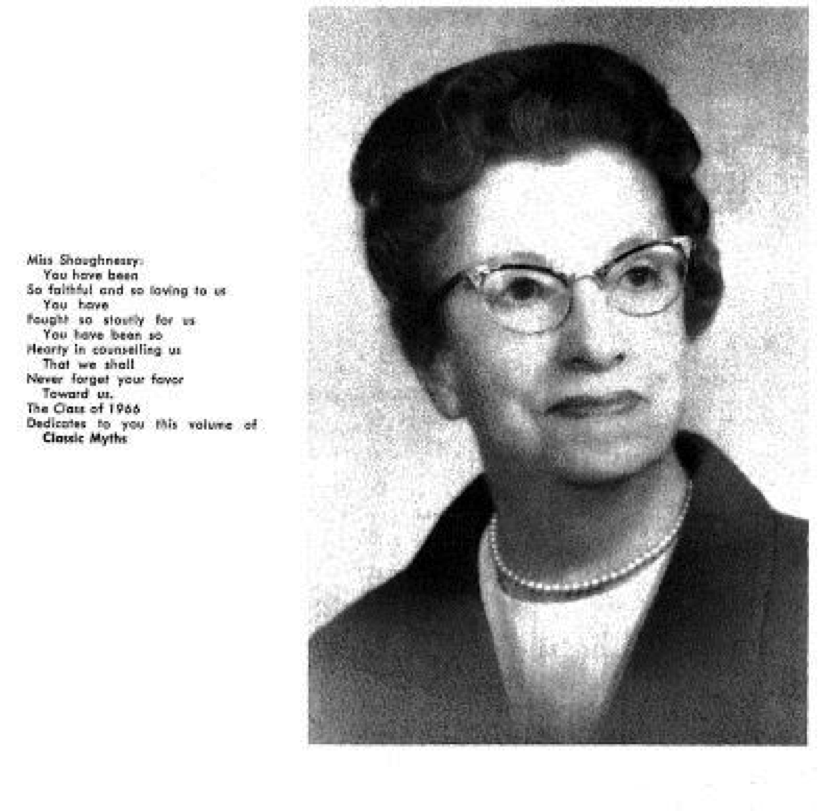
Dedication to Anna C. Shaugnessy from the Classical High School yearbook of 1966.

Stanley Kunitz/Photo by Cheryl Richards

THE BOARD OF ARGUS, CLASSICAL HIGH SCHOOL’S LITERARY MAGAZINE, 1927-1928. OLSON IS CENTER BACK/CHARLES OLSON RESEARCH COLLECTION, SERIES: PHOTOGRAPHS, BOX 322, ARCHIVES AND SPECIAL COLLECTIONS AT THE THOMAS J. DODD RESEARCH CENTER, UNIVERSITY OF CONNECTICUT LIBRARIES. USED WITH PERMISSION

CHARLES OLSON/ COPYRIGHT 2015 ELSA DORFMAN/ALL RIGHTS RESERVED/ COURTESY COLOTTECOFBOSTON

milton meltzer
***
Postscript: Nicholas Gage on Anna Shaughnessy

NICHOLAS GAGE/PHOTO BY MARI SEDER

The author with a group of Afghani children/photo by jason Boulay

Charlie Rubin and Jacob Beranger/Photo by Dan Leventhal

Erik Abramson with Yan Perez/Photo by Michael Abramson
by Orfa Torres Fermín

A wordcloud based on this article. Design by worditout.com
While in line at the post office a few months ago, I witnessed a man eavesdropping on a Latina chatting with a female companion.
“Speak English,” he said. “You’re not in Mexico.”
The woman, seemingly ashamed, looked at her friend, lowered her voice and head, and continued to speak.
She wasn’t speaking to him.
She wasn’t even speaking Spanish.
I came to the United States of America, my adoptive motherland, when I was in 4th grade. At ten years old, I effortlessly spoke, wrote, read, and sang in Spanish. Soon after enrolling in the Worcester (Massachusetts) Public School system I was placed in ESL classes. I was extremely excited at the prospect of learning English and all that it entailed. I did my best to learn the language. I read English books at home and watched Full House, Punky Brewster, and The Fresh Prince of Bel-Air in the belief that the more English TV I watched and the more English literature I read, the sooner I would learn English. A year and a half later, I was transitioned into English-only classes. There, I was constantly reminded of my accent and the importance of getting rid of it. I was placed in speech classes in order to work on my pronunciation. I worked hard to try to domesticate my unruly tongue.
My inability to master English pronunciation led me to the conclusion that there was something wrong with me. I am now an adult and continue to have an accent—a prominent and untamable one at that. While I proudly remain fluent in Spanish, I now also manipulate the English language with pride. I think in both languages. I find that I am able to better rationalize watching and listening to the news in English but favor reading the newspaper in Spanish. I write better in English yet speak better in Spanish. As a consequence, much of my cognitive exchanges are spent filtering words from English to Spanish or vice versa.
I have met many people, who, like the younger me, feel the need to suppress their Spanish language and accents. They battle with their use of what linguists call code-switching (as well as language, code-switching also involves switching between gestures, social interaction, and culture). You are probably familiar with code-switching as Spanglish. The Spanish-speakers attempting to juggle two languages understand that in order to fit in they need to, like many before them, assimilate to the new language. Many of them walk around feeling the way I did as a child, that there is something wrong with them, a wrongness that is obvious the moment they open their mouths to speak.
By the end of this century, the Latino community will comprise the biggest minority group in the United States. By that time, since the use of Spanish is seldom encouraged, English, and not Spanish will be the mother tongue of most Latinos. This notion creates a problem for Latinos who are caught between two cultures and deal with the complexities of living between two languages on a daily basis.
Language plays a fundamental role in a person’s sense of self. Culture, which includes language, forms our beliefs and shapes our perception of reality. Culture allows people to understand their surroundings and communicate; as with language, culture helps the community transmit the philosophies dear to them.
Code-switching is an aptitude, yet it is profoundly discriminated against, most often by those who speak only one language. The Latino use of code-switching in the United States is a cultural performance deeply frowned upon. For the Latina writer, though, the use of code-switching is a necessity, a tool through which she is able to achieve autonomy. In literature, code-switching is recognized as a literary technique that allows for the alternation between two or more languages in the same text. It can be found in all forms of literature, and it is the natural result of the constant growth in the Hispanic population from the early nineteenth century through to today.
Although it can be argued that the use of code-switching in written text is a political statement against the monolithic use of English—this may be what the man in the line at the post office was worried about—it can also be argued that those who code-switch do it because it is part of their identity, a marker. Code-switching is a representation of the reality of those who live in a liminal state, not only between vernaculars, but also between cultures.
According to Lev Vygotsky, a psychologist who pioneered research into cognitive development, “Language … is the tool of culture which enables social interaction, and thus the direction of behavior and attitudes.” Since culture plays an essential role in the cognitive development of a person, the language in which an individual communicates should not to be regarded as an insignificant.
Code-switching is shows the ambiguities of one who stands in an uncomfortable territory, a place of contradictions, illegitimacy, and manipulation. Code-switching is a language born out of boundaries. It is a mode of communication indispensable to achieving self-efficacy and subsequently self-expression.
Identity and belonging are crucial to the development of human beings. People who have a strong sense of their identity understand and accept where they come from–their cultural history, language, religion, and the environment that helped shape them. People achieve a sense of belonging when their culture is accepted rather than questioned, suppressed or judged.
Code-switching, in this sense, is more than a personal choice. It defines a person and allows him or her to achieve completeness. The failure to fully understand the immigrant experience, the reasons that drive people to leave their countries of birth and journey to the United States, their drives, beliefs, and what shapes them, is what keeps many from understanding that people who code-switch do not do so as a simple rejection of the English language or to keep monolinguals out, but rather because code-switching is the language that the newer generations have come to know as natural.
Orfa Torres Fermin is a Worcester resident and Clark University English and business student. She enjoys researching and writing about women and gender studies, cultural theory, and social and cultural marginalization. She is a self-confessed coffee aficionado, do-it-yourself(er), and photographer. Orfa believes in equality and hopes to live by her pen.

Photo by nick porcella

photo by nick porcella

by Sarah Leidhold

Three women By pablo Picasso, Pablo/State Hermitage / Culture Images / Universal Images Group/all Rights Managed
0
0
1
250
1429
WPI
11
3
1676
14.0
Normal
0
false
false
false
EN-US
JA
X-NONE
/* Style Definitions */
table.MsoNormalTable
{mso-style-name:”Table Normal”;
mso-tstyle-rowband-size:0;
mso-tstyle-colband-size:0;
mso-style-noshow:yes;
mso-style-priority:99;
mso-style-parent:””;
mso-padding-alt:0in 5.4pt 0in 5.4pt;
mso-para-margin:0in;
mso-para-margin-bottom:.0001pt;
mso-pagination:widow-orphan;
font-size:12.0pt;
font-family:Cambria;
mso-ascii-font-family:Cambria;
mso-ascii-theme-font:minor-latin;
mso-hansi-font-family:Cambria;
mso-hansi-theme-font:minor-latin;}
Globally, one in three women will be raped, beaten, coerced into sex or otherwise abused in her lifetime.
-From a report by UNIFEM, the women’s fund at the United Nations.
Walk like the wolverine
awaiting attack–
grasp your cold metal keys
like a weapon
in case the bones behind
your knuckles aren’t strong
enough to crack the skull
that’s holding the brain
that’s hatching the plan
to hurt you.
You must be ready.
One in three—
you,
her,
or me.
Restrain your provoking
siren self.
They are easily stimulated.
Every night is
their mating season.
Float just above
the pavement, silent.
Travel in packs;
drape your skirts just
below the come-hither
curves of your ankles.
They can detect fear
in their knowing nostrils–
listen for the crinkle of recognition
and the howl of pursuit.
Slink through the shadows
but avoid the darkness.
Slip ninja stars
into your bra cups
and spray yourself
with skunk musk
instead of perfume.
One in three—
you
her,
or me.
Sarah Leidhold, an overzealous student at Worcester State University, harbors a pervasive addiction to both producing and absorbing poetry. She especially enjoys the uninhibited spilling out of inspired sentiments in the all-accepting form of free verse. More of her work can be found here.
Photo credit: http://quest.eb.com/search/525_2913015/1/525_2913015/cite










“Prismatic Pop”/Mixed Media (Pastel, Colored Pencil, Watercolor, Marker, & Glitter)

INFOGRAPHICS LIKE THIS ONE, WHICH CHARTS WHICH U.S. REGIONS PHISH HAS VISITED ON EACH OF ITS TOURS, ARE COMMONPLACE ON PHISH.NET’S BLOG. IMAGE COURTESY OF PHISH.NET/THE MOCKINGBIRD FOUNDATION.
0
0
1
918
5234
WPI
43
12
6140
14.0
Normal
0
false
false
false
EN-US
JA
X-NONE
/* Style Definitions */
table.MsoNormalTable
{mso-style-name:”Table Normal”;
mso-tstyle-rowband-size:0;
mso-tstyle-colband-size:0;
mso-style-noshow:yes;
mso-style-priority:99;
mso-style-parent:””;
mso-padding-alt:0in 5.4pt 0in 5.4pt;
mso-para-margin:0in;
mso-para-margin-bottom:.0001pt;
mso-pagination:widow-orphan;
font-size:12.0pt;
font-family:”Berling Antiqua”;}
By Warren Singh

Shane Carruth and Amy Seimetz in Upstream Color / Shane Carruth
It’s complicated.
I think.
Maybe the most incomprehensible thing about Shane Carruth’s film Upstream Color is that it is, in fact, comprehensible.
Perhaps.
My previous experience with Carruth was with his 2004 film, Primer, which was a polished gem of a time travel movie that refused to dumb anything down for the sake of comprehensibility.
Upstream Color opens with Kris, a woman played by Amy Seimetz, who is drugged with a substance from a forcibly ingested roundworm that induces extreme psychological malleability. The assailant then essentially hypnotizes her into emptying her bank accounts and makes off with all of her assets. But this isn’t really about Thief (no really, in the credits he’s simply Thief). The theft really only sets the stage for the rest of the film.
A year later, Kris meets Jeff, played by writer/director Carruth, and they fall in love. But the movie isn’t all about boy-meets-girl, secrets revealed, happily ever after, either. That’s certainly a large element in the movie, but also significant is the role of the parasite itself. It’s never fully explained, but we do know that the life cycle consists of the following: a man known as Keeper (actually credited as Sampler) extracts the roundworm from the victim, and then transplants it into one of the pigs he keeps on a pig farm. Any offspring from the pigs are placed in a burlap sack and thrown into a nearby river. The decomposing bodies then release an unnamed compound that is absorbed by a white flower downstream, which then turns blue. The flowers are collected and sold – and it is the blue color that indicates that the drug-secreting worms are present in the potting soil (this is where Thief gets the worms that he uses on the victims).
Still with me? From pig to plant to human to pig: this is the lifecycle of the parasite, and it’s this cycle that unites all of the characters.
So is the movie about unification? Not quite. Sampler is able see out of the eyes of victims through a connection they have with the pigs whose parasites they ingested, and we see their lives after the fact (they are dramatically different, as job loss and financial ruin frequently follow from Thief’s actions).
It’s about connection, then? Closer. One critical view has been that it’s about identity: how it forms, fractures, and then is rebuilt.
To me, the movie is about trauma. Thief at the beginning of the movie victimizes both Kris and Jeff, even though we see only Kris’ experience. After a time skip, we see the two meet and get to know each other. The effects of the trauma are evident on Kris: when the two get coffee, she pulls out her pills and places the bottles on the table, flatly stating, “this is to save us time.” We’re left to conjecture that she’s on the medication due to the financial, emotional, and professional impact of the drug. She now works an entry-level job at a printing and signage shop, a huge step down from the corporate position she held before.
Jeff isn’t fazed, however, and continues to pursue her. Jeff has also suffered similarly, becoming a pariah in his workplace. And so the outcast and the damsel in depression become a team.
These events are also reflected in the lives of their pigs: the two pigs that correspond to Jeff and Kris are found by Sampler to have paired off at the farm, and eventually have a litter of piglets.
When Sampler drowns this litter, Kris runs out of her workplace on the verge of tears, punching through a window as she leaves. Jeff becomes angry, drops a box of papers, and sprints for the exit, bowling over two coworkers on the way.
They find their way to each other, and make their way home. Running inside, buffeted by emotional forces that neither can explain, they crawl into the bathtub, where, surrounded by emergency supplies, in a room lit by flashlight, they hold each other and wait for the storm to pass.
Upstream Color follows the characters after they suffer at the hands of Thief and become part of the life cycle of the parasite, and the movie then shows the aftermath: the tenuous regaining of equilibrium, the aftershocks, the slow recovery, and finally, the taking back of control at the end of the film through the only real plot ‘twist’ (it’s more of a shake-up) in the movie. The importance of the reclamation of agency is explicitly stated (or as close to explicit as the movie ever gets) when Kris warns Jeff before going out with him, “It’s not my fault when things go wrong.” Jeff tellingly replies, “Yes it is.”
As a sensory experience, Upstream Color is distinct from most mainstream movies, although perhaps that owes more to its belonging to the ‘independent’ category (it premiered at the Sundance Film Festival in 2013) with a color palette that makes for a slow moving, evocative journey that is complemented by the ambient soundtrack. Carruth himself composed the music for the film, and it’s perhaps due to his involvement in every major aspect of the movie that it feels so deliberate: it’s not a frou-frou flapping about, but a constructed, defined piece of cinema with a purpose.
Sometimes with Carruth (OK, most times) that purpose is hard to grasp. Carruth isn’t one to spoon-feed the viewer, and this is a demanding film.
Upstream Color is absolutely worth watching. It’s a complex film that defies quick explanation, rife with alternative approaches to direction, narrative, writing, and sound. It’s a film that many of my acquaintances (and yours too, I suspect) would dismiss as too art-house. It’s definitely a film that is on the outer side of the artistic envelope. It’s also a film that I’m still mulling over close to a year after watching it for the first time.
So go do me a favor and watch Upstream Color. And after you’ve finished, come find me and tell me what you thought the movie was about (no seriously; I’ll buy you a cup of coffee). Because I think it’s complicated.
Upstream Color can be bought and downloaded here.
Warren Singh is a bookworm and wiseacre who sometimes goes undercover as a writer. He also occasionally pretends to be studying chemical engineering at Worcester Polytechnic Institute, Worcester, Mass. Sinecures, paeans, and disproportionately massive bribes may be proffered at probablystillsomewhatincorrect.wordpress.com
 
;
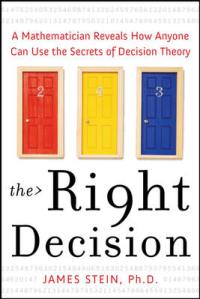
0
0
1
362
2069
WPI
17
4
2427
14.0
Normal
0
false
false
false
EN-US
JA
X-NONE
/* Style Definitions */
table.MsoNormalTable
{mso-style-name:”Table Normal”;
mso-tstyle-rowband-size:0;
mso-tstyle-colband-size:0;
mso-style-noshow:yes;
mso-style-priority:99;
mso-style-parent:””;
mso-padding-alt:0in 5.4pt 0in 5.4pt;
mso-para-margin:0in;
mso-para-margin-bottom:.0001pt;
mso-pagination:widow-orphan;
font-size:12.0pt;
font-family:”Berling Antiqua”;}
by Warren Singh
Decision time, and the fate of the free world hangs in the balance: it’s 1939, and I’ve been put in charge of a new top-secret government project called The Manhattan Project, devoted to developing a game-changing weapon in competition with the Nazis. Given the circumstances, it’s a little nerve-wracking to consider the first thing that I have to do, which is choose a second-in-command to lead the team of physicists that will be the heart and soul of the endeavor.
I’m on page 18 of The Right Decision, an immensely fun read, despite being written like a textbook (which, being published by McGraw Hill, is probably intentional) regarding how to make decisions.
Written by a math professor named James Stein, the book draws from the fields of mathematics and economics (more specifically, decision and game theory) to address better ways of weighing and choosing options. Its chapters are divided into various broad topics: the first part of the book covers an idea central to decision theory, the ‘payoff factor’. Really, it’s a fancy way of saying, ‘what is it that you want out of this?’ Subsequent chapters deal with various ways of assessing the core idea, such as the inadmissibility option (if an option is inferior to other, similar ones, drop it like it’s on fire) or the Bayes criterion (which choice works out best on average?).
Midway, the book takes a pleasantly diverting turn, the reasons for which Stein explains at the beginning. He writes that one doesn’t learn to ride a bike solely by reading about it: you instead take a few core ideas, and then go and practice them until it clicks. Then you vary the situation and do it again. This is what he aims to do with the book, and this is where the fun is. Interspersed through the chapters are problems presented for the reader, in which Stein presents a real or hypothetical scenario and asks what you, the reader, would do. Spanning such diverse scenarios as “my best friend and his girl are having trouble and have broken up, when can I make a move for her” to “in what direction should you take your multinational corporation at this critical juncture,” these problems are immensely entertaining.
The author writes that he hopes that doing these puzzles will be just as entertaining as crosswords or Sudoku, but with the added benefit of helping us make decisions. Stein offers 28 scenarios, complete with solutions. He advises tackling one a day for a month, with the hope that at the end of it, the reader will have vastly improved decision-making skills.
Stein argues that we are the sum of our decisions, his point being that our decisions won’t always lead to good things, as the real world frequently has factors that we can’t influence, but over the long haul good decisions tend to add up better than bad ones.
It reminded me of a championship poker player, who wrote that poker is a discrete game: that is, all the odds are known. If all the odds are known by everyone at the table, then what separates champions from the merely adequate? Well, as he explains, even though the probabilities in poker are well defined, it is possible to make the correct play (there’s always a correct play, given that the probabilities are limited) and lose. A champion player is someone who can make the right play five times in a row, lose five times in a row, and the sixth time, still make the correct play.
The Right Decision doesn’t pretend to deal a winning hand, much less guarantee a good payoff. But it does teach one how to assess the odds, which is oddly liberating. In the end, there are no guarantees, and all we can do is play a beautiful game.
0
0
1
69
395
WPI
3
1
463
14.0
Normal
0
false
false
false
EN-US
JA
X-NONE
/* Style Definitions */
table.MsoNormalTable
{mso-style-name:”Table Normal”;
mso-tstyle-rowband-size:0;
mso-tstyle-colband-size:0;
mso-style-noshow:yes;
mso-style-priority:99;
mso-style-parent:””;
mso-padding-alt:0in 5.4pt 0in 5.4pt;
mso-para-margin:0in;
mso-para-margin-bottom:.0001pt;
mso-pagination:widow-orphan;
font-size:12.0pt;
font-family:Cambria;
mso-ascii-font-family:Cambria;
mso-ascii-theme-font:minor-latin;
mso-hansi-font-family:Cambria;
mso-hansi-theme-font:minor-latin;}
0
0
1
69
395
WPI
3
1
463
14.0
Normal
0
false
false
false
EN-US
JA
X-NONE
/* Style Definitions */
table.MsoNormalTable
{mso-style-name:”Table Normal”;
mso-tstyle-rowband-size:0;
mso-tstyle-colband-size:0;
mso-style-noshow:yes;
mso-style-priority:99;
mso-style-parent:””;
mso-padding-alt:0in 5.4pt 0in 5.4pt;
mso-para-margin:0in;
mso-para-margin-bottom:.0001pt;
mso-pagination:widow-orphan;
font-size:12.0pt;
font-family:Cambria;
mso-ascii-font-family:Cambria;
mso-ascii-theme-font:minor-latin;
mso-hansi-font-family:Cambria;
mso-hansi-theme-font:minor-latin;}
Warren Singh is a bookworm and wiseacre who sometimes goes undercover as a writer. He also occasionally pretends to be studying chemical engineering at Worcester Polytechnic Institute, Worcester, Mass. Sinecures, paeans, and disproportionately massive bribes may be proffered at probablystillsomewhatincorrect.wordpress.com
0
0
1
686
3916
WPI
32
9
4593
14.0
Normal
0
false
false
false
EN-US
JA
X-NONE
/* Style Definitions */
table.MsoNormalTable
{mso-style-name:”Table Normal”;
mso-tstyle-rowband-size:0;
mso-tstyle-colband-size:0;
mso-style-noshow:yes;
mso-style-priority:99;
mso-style-parent:””;
mso-padding-alt:0in 5.4pt 0in 5.4pt;
mso-para-margin-top:0in;
mso-para-margin-right:0in;
mso-para-margin-bottom:8.0pt;
mso-para-margin-left:0in;
line-height:107%;
mso-pagination:widow-orphan;
font-size:11.0pt;
font-family:Calibri;
mso-ascii-font-family:Calibri;
mso-ascii-theme-font:minor-latin;
mso-hansi-font-family:Calibri;
mso-hansi-theme-font:minor-latin;}
by Abby Frias

As a niña, the smells of rice, beans, and plantains seeping beneath my grandparents’ door were so strong that I believed they possessed magic. Like fairy dust, the perfume would billow through the cracks and spread down the retirement home’s hallway, putting every other apartment under my grandparents’ velvety Dominican spell.
Today, as a high school junior, I find my grandmother’s cooking no less enchanting. I ascend in the building’s elevator, and anxiety weighs heavier with each passing floor. I mentally prep my brain for rapid translations, verb conjugations, topics of conversation, until — Ding. The elevator doors open and an immediate plume of warmth melts my nervousness.
I stand and read the bronzed numbers on the last door on the right. 455. Quatrocientos
0
0
1
2
16
WPI
1
1
17
14.0
Normal
0
false
false
false
EN-US
JA
X-NONE
/* Style Definitions */
table.MsoNormalTable
{mso-style-name:”Table Normal”;
mso-tstyle-rowband-size:0;
mso-tstyle-colband-size:0;
mso-style-noshow:yes;
mso-style-priority:99;
mso-style-parent:””;
mso-padding-alt:0in 5.4pt 0in 5.4pt;
mso-para-margin:0in;
mso-para-margin-bottom:.0001pt;
mso-pagination:widow-orphan;
font-size:12.0pt;
font-family:Cambria;
mso-ascii-font-family:Cambria;
mso-ascii-theme-font:minor-latin;
mso-hansi-font-family:Cambria;
mso-hansi-theme-font:minor-latin;}
cincuenta y cinco? My Spanish is not what it should be. I knock.The door opens and my grandfather beams at me.
“¡Hola chica! ¿Como estás?”
“¡Hola abuelo!” These words I know, having used the greeting countless times over the years. I feel safe and relaxed in my grandfather’s strong embrace.
“Abigalita.” From behind, a different, gentler voice. Mi abuelita. I turn and smile into the deep glimmer in her wise eyes–ponds sparkling under moonlight. Her wrinkles swell and recede as she smiles up at me. A brown, weathered canvas of strength, each line and etched tale of strength, joy and, of course, grief. My father’s passing undoubtedly left emotional and physical scarring. I have had several years to mourn and cope with the loss, but each visit is a reminder of all of the possible conversations between my grandparents and I that never happen because of my rudimentary Spanish skills.
***
0
0
1
72
416
WPI
3
1
487
14.0
Normal
0
false
false
false
EN-US
JA
X-NONE
/* Style Definitions */
table.MsoNormalTable
{mso-style-name:”Table Normal”;
mso-tstyle-rowband-size:0;
mso-tstyle-colband-size:0;
mso-style-noshow:yes;
mso-style-priority:99;
mso-style-parent:””;
mso-padding-alt:0in 5.4pt 0in 5.4pt;
mso-para-margin:0in;
mso-para-margin-bottom:.0001pt;
mso-pagination:widow-orphan;
font-size:12.0pt;
font-family:Cambria;
mso-ascii-font-family:Cambria;
mso-ascii-theme-font:minor-latin;
mso-hansi-font-family:Cambria;
mso-hansi-theme-font:minor-latin;}
In the 1970’s, my grandparents emigrated from the Dominican Republic with their four sons. They worked in New York City, diligently crafting a better future for their family and unborn generations. But the land of opportunity came at a price. By the time their grandchildren came along, both my abuela and abuelo were far too oriented to their native tongue. We were free to enjoy each other’s food and company; however, my grandparents’ and I lacked the foundation of a shared language.
They did not give up, however. I remember at the age of five joining them at their English classes and “assisting” the teacher each day. My grandfather learned to string together phrases in the strange, new language, but my grandmother had a harder time. Thus, I’ve learned to read the “context clues”– body language, facial expressions, and hand gestures– to decipher her meanings.
“Abigailita, ¿Quieres comer?” My grandmother motions to the dining room table and pulls out a chair.
The table is filled with pastelitos, yuca, beans and other delicious dishes. The three of us join hands, my clammy fingers and chipped black nail polish against the smooth, cocoa-butter enriched grooves and arches of their palms. I squeeze tightly and lower my head.
They wish me a successful junior year of high school, good health and good grades and that God gives me a long life with joy, happiness, and–a good sweater? Wait, suerte doesn’t mean sweater, it means luck. They ask that God grant us many meals in the future and that God looks after Ramon.
Ramon. It’s my father’s name–his real name, not the Anglicized “Ray” that I heard most often. I repeat it in my head, rolling the “r” and emphasizing the “mon.” I repeat it once more, aloud, and raise my head as a pause of silence blankets our prayer circle. My grandfather’s eyes are brimming with tears. I hug him and smile. We say “Amen.”
***
I am flourishing under the parenting of my Irish-American mother and Italian-American stepfather–two amazing, nurturing, loving parents. Yet when I’m with my grandparents, we three always seem silently aware of the absence of Ramon, Ray, their son, my dad. This absence of a wnoderful man is like a branch broken from our family tree. But between mouthfuls of rice and circles of prayer, I recognize the tree’s undying strength. I feel safe and loved under its shade.
Abby Frias is a student in the Wachusett Regional School District. She hopes to pursue a writing career and study political science in college.
Photo Credit:
Oak Trees in Farm Field. [Photography]. Encyclopædia Britannica ImageQuest. Retrieved 14 Jan 2015, from
http://quest.eb.com/#/search/300_2265907/1/300_2265907/cite
by Sasha Kohan
Punk was defined by an attitude rather than a musical style.
— David Byrne
0
0
1
1412
8050
Boston College
67
18
9444
14.0
Normal
0
false
false
false
EN-US
JA
X-NONE
/* Style Definitions */
table.MsoNormalTable
{mso-style-name:”Table Normal”;
mso-tstyle-rowband-size:0;
mso-tstyle-colband-size:0;
mso-style-noshow:yes;
mso-style-priority:99;
mso-style-parent:””;
mso-padding-alt:0in 5.4pt 0in 5.4pt;
mso-para-margin:0in;
mso-para-margin-bottom:.0001pt;
line-height:115%;
mso-pagination:widow-orphan;
font-size:11.0pt;
mso-bidi-font-size:10.0pt;
font-family:Arial;
color:black;}
To be clear: I am not here to talk about what’s punk and what’s not. As much as I’d like to have the authority to do so, my knowledge of punk is scant compared to what I really love – pop. And while the two may seem to be diametrically opposed, it seems to me that pop is beginning to take a few small but visible notes from punk’s playbook.
Pop culture infiltrates our lives – in fashion, film, slang, TV – trickling through our minds, memories, and conversations in big and small ways, but perhaps most obviously in music. And right now – sorry guys – women own the playing field. The influence these women can have (and are already having) on thousands of girls today could be immense, but what are we actually learning from them? And is it really as bad as some people seem to think?
Exhibit A: Taylor Swift. Undeniably attractive as she may be, the seven-time Grammy winner is also undeniably more conservative than most of her other female pop peers, somehow remaining as innocent and adorable as when she released her debut album in 2006; for all we know, Ms. Swift has been completely sober and sexless for all her twenty five enchanting years on earth. Despite the self-professed confessional nature of her songwriting, criticism of what some may call an obsession with boys continues to crop up year after year. Referred to as “a feminist’s nightmare” by Jezebel, Swift has publicly admitted that her relationships are most often what inspires the strong feelings behind her songs, with countless defenders who thrive on the connection built between the artist and fans in hearing familiar stories and moments retold in such an articulate, relatable voice. What some interpret to be a “feminist’s nightmare” is Swift’s apparent inability to write about anything but these relationships, with haters arguing that the lyrical message of her music is little more than simply, BOYS; fans, however, see something very different.

Lana del rey performing at the isle of wight festival in 2012 / amir Hussein / Getty Images Entertainment / Getty Images / Universal Images Group
NPR interestingly called Swift a “princess of punk” upon the release of her fourth album, Red, in 2012, commenting on the noticeably new attitude of the songs and noting that Swift’s growth is evident in the tones of both anger and acceptance (as opposed to what might have previously been called whining and obsession) felt throughout the album. Swift’s maturation is by far most visible in light of her newly-released fifth studio album, 1989, and is perhaps most palpable in the single “Blank Space” and its music video. In what the New York Times called a “metanarrative” about her reputation as a perpetually lovelorn, occasionally clingy ex-girlfriend, Swift seems to have directly dedicated “Blank Space” to her haters, shamelessly acknowledging her notoriety in lines like “You look like my next mistake” and the gleefully knowing chorus, “Got a long list of ex-lovers / They’ll tell you I’m insane / But you know I love the players / And you love the game.” The accompanying video brings Swift’s self-awareness to a new level, following a traditional fairy-tale love story and featuring caricatures of Swift’s alternately girl-next-door and crazy-ex personas, teaching us just as much about rolling with the punches and knowing yourself as her earlier songs did with issues of growing up and dealing with young love and heartbreak. Swift is in good company though: fellow pop princess Lana Del Rey also defied the mainstream culture by abandoning the reputation built by hip-hop inspired Born to Die (2012) when packing her second album Ultraviolence (2014) full of slow, psychedelic songs, none of which make the traditional three-minute radio cut. Del Rey took a bow to her skeptics as well, most notably in the Ultraviolence song “Brooklyn Baby,” which highlights haters’ perceptions of the artist whom Rolling Stone called “rock’s saddest, baddest diva” as an unapologetic hipster. Swift may have taken a note from Del Rey’s book as she gave her haters exactly what they were looking for in “Blank Space.” Though Swift’s sugar-sweet, pure-as-a-virgin image may have made (and continues to make) her music marketable to younger listeners and often causes older ones to undermine or disregard her music, Swift is undeniably succeeding in the powerful cultural position she holds – in fact, because her sound is so accessible to young girls, she is actually instilling her ideas of how to work through relationships and expressing strong feelings in girls at a younger age – kind of empowering, right? And isn’t that the kind of ability we’d like our daughters growing up with?
The one girl who probably has the most to say on growing up is actually the youngest of most pop stars on the radar right now. At 16, Lorde topped the U.S. Billboard Charts in 2013 with her hit “Royals,” from her debut album, Pure Heroine (the name itself basically says all you need to know). Now, at 18 years old, Lorde remains admirable in a traditional sense — incredibly talented, wildly successful — yet at the same time “punk” in the way she defies our expectations; a 16-year-old girl writes an album almost entirely absent of boys, romance, or sex? Her incredibly impressive debut instead focused mainly on the concept of youth and the strangeness of getting older, a theme as universal as Ms. Swift’s obsession with writing about boys. “Royals” even challenges the elements of songs on the radio as of late: “But every song’s like gold teeth, Grey Goose, trippin’ in the bathroom / blood stains, ball gowns, trashin’ the hotel room / we don’t care.” How punk is it to write a number one international hit song that rolls its eyes at every other number one hit?
And then there’s Miley. Once the woman of the hour, arguably old news, yet consistently relevant and discussed amongst fans and cynics alike.
Ridding herself of the long, luscious, Hannah Montana locks in favor of a Twiggy-inspired shaved head and bleach blonde bangs, and crowned as “Princess of Twerk” by tabloids everywhere.. Cyrus has gone through an incredible transformation. Under intense public scrutiny for the majority of her life, the singer received shocking amounts of negative publicity in the aftermath of the controversial 2013 VMA performance. Her public sexuality and discussion of drug use has been criticized as an overly dramatic way of saying, “Y’all check me out, I’m not a kid anymore,” and her carefree attitude towards the situation has upset parents telling CNN they are now forced to think that Cyrus does not either a) care what her younger fans think of her or b) hasn’t even bothered to think of what her actions are doing to her image…but isn’t that what continues to make her so awesome?

miley cyrus performing in london
Despite the scandal created around her new look, Cyrus is flourishing more than ever because she simply does not care – which is why VICE magazine even went so far as to call her “the most punk rock musician around” at the height of her controversy. Subsequent appearances on Saturday Night Live and The Ellen Show proved her capacity for eloquence, honesty, and a good sense of humor (about herself) and what it’s like to suddenly be the most talked-about person in the world. She’s not perfect, but she’s rich, pretty, and testing her limits, paving the way for her own independent image, trying to figure out who she is.
That Cyrus can disguise her fourth album, Bangerz, (which is, in fact, a breakup album) as what most angelheaded hipsters would write off as another shitty pop record trying too hard to get in the Top 40 is actually an incredible feat. When some girls might be tempted to fill their album with acoustic emotion and bittersweet strings, Cyrus shook off her broken engagement with actor Liam Hemsworth by reestablishing her confidence in herself: “So don’t you worry ‘bout me, Imma be okay / Imma do my thang.” The lyrics of the album tell the story of real feelings, but the upbeat quality of most of the songs instills a sense of conviction and empowerment – occasionally admitting to unhappiness, but never giving in to it. “Wrecking Ball” is the obvious exception, but we can allow her a few minutes of sadness, right? And can we please allow her to wear what she wants? To dance how she wants? Though the initial hysteria surrounding the transformation of Ms. Cyrus has faded, I think it’s important to remember how harshly and cynically many of us reacted. Everyone has (had) at least a little bit of Miley in us, in our reckless, fun, experimental youth. We watched her evolve and now here she is, and some people still want to criticize her for not keeping things PG? All I can say is: grow up.
Rock critic Lester Bangs said that “punk represents a fundamental and age-old Utopian dream: that if you give people the license to be as outrageous as they want in absolutely any fashion they can dream up, they’ll be creative about it, and do something good besides.” Not to say that girls like Miley, Taylor Swift, Lana Del Rey, and Lorde are punk musicians — not at all — but they’re bringing an element of the tradition into mainstream popular music. The women of pop are stronger than ever as they continue to top the charts, make bank, and make the news every week, joining the ranks of Beyoncé, Lady Gaga, and other established queens of the radio. As they use their words, sounds, and images to express themselves with confidence and be who they choose to be, listeners of our generation should feel more and more comfortable following suit. Punk is, after all, “just another word for freedom.”
Editor’s Note: An earlier version of this article appeared in the magazine STIR in 2013.
Sasha Kohan is a student at Clark University, Worcester, Mass., studying English and Screen Studies.
Photo credits:
5th Annual ACM Honors – Red Carpet. [Photography]. Encyclopædia Britannica ImageQuest. Retrieved 14 Jan 2015, from
http://quest.eb.com/#/search/115_3897402/1/115_3897402/cite
Isle of Wight Festival – Day 2. [Photography]. Encyclopædia Britannica ImageQuest. Retrieved 21 Jan 2015, from
http://quest.eb.com/#/search/115_3972752/1/115_3972752/cite
Capital FM’s Jingle Bell Ball – Day One – Show – London. [Photography]. Encyclopædia Britannica ImageQuest. Retrieved 14 Jan 2015, from
0
0
1
935
5331
WPI
44
12
6254
14.0
Normal
0
false
false
false
EN-US
JA
X-NONE
/* Style Definitions */
table.MsoNormalTable
{mso-style-name:”Table Normal”;
mso-tstyle-rowband-size:0;
mso-tstyle-colband-size:0;
mso-style-noshow:yes;
mso-style-priority:99;
mso-style-parent:””;
mso-padding-alt:0in 5.4pt 0in 5.4pt;
mso-para-margin-top:0in;
mso-para-margin-right:0in;
mso-para-margin-bottom:8.0pt;
mso-para-margin-left:0in;
line-height:107%;
mso-pagination:widow-orphan;
font-size:11.0pt;
font-family:Calibri;
mso-ascii-font-family:Calibri;
mso-ascii-theme-font:minor-latin;
mso-hansi-font-family:Calibri;
mso-hansi-theme-font:minor-latin;}
by Alexandra D’Ordine

DOCTOR WHO (Peter Capaldi) and clara oswald (Jenna Coleman) in the tardis / BBC
Walk into any sci-fi convention like Comic-Con and you’re bound to find a few people dressed as metal-encased Daleks and hear the buzzing of a sonic screwdriver. You may even run into attendees wearing bowties or curiously striped scarves and shouting “Allons-y!” If these elements don’t ring a bell, you’re most likely part of the ever-decreasing population of Americans who are unfamiliar with the British television show and cultural phenomenon, Doctor Who.
After celebrating its 51st anniversary last year, Doctor Who is as popular as ever. Throughout its long history, the premise has remained the same: an alien time-traveler, a Time Lord called the Doctor, scoops up various companions and shows them the universe via his living time machine, a blue police box called the T.A.R.D.I.S, which stands for Time and Relative Dimension in Space (a police box is an obsolete telephone callbox for use by the police). Every so often, the Doctor regenerates, meaning his body and personality changes in response to a deadly force. This plot line and the constant replacement of the Doctor’s companions have allowed the show to continue more than half a century.
The show has had its ups and downs in the U.K., including the series’ cancellation in 1989 and a 1996 film version that received a lukewarm response. However, the revived series that began in 2005 has returned the show to its former popularity and more.
Alan Kistler, author of Doctor Who: A History, is familiar with how the show has changed over the years.
“In the revival series, I think the first two years were a major high point, redefining the show and stripping the mythology of Doctor Who back to basics–a strange and mysterious alien on his own who wanted to explore the impossible,” said Kistler. “By 2005, you also had the BBC now adopting what had been successful in the U.S. in making science fiction shows more mainstream.”
The show was not completely new to the U.S. Some of the pre-2005 episodes were shown on PBS, but they didn’t catch on. SyFy offered the revived series but was unable to achieve the necessary audience. Then, in 2009, BBC America started airing current episodes at roughly the same time as they were broadcast in the U.K. It was a success. The premiere of the fifth series in 2010 had 1.2 million viewers, according to The Hollywood Reporter, which at the time was a record for any show on BBC America.
“BBC America started a stronger U.S. advertising campaign starting with season 6, so that’s definitely pushed its popularity further,” said Kistler.
Three years later, the 50th anniversary special was shown in 94 countries on six continents, achieving the Guinness World Record for the largest simulcast of a TV drama. Many of these viewers were in the U.S., one of the few countries in which the special was also shown in theaters.
Since last year it has become even more popular, with the premiere of the eighth series on August 23, 2014 attracting 2.58 million viewers, making it the highest rated premiere ever on BBC America, according to TV By the Numbers.
Glenn Grothaus is a Doctor Who enthusiast from St. Louis, Missouri, who started watching the show in 2010 and has been a fan, or “Whovian,” ever since. Last summer he attended the St. Louis Comic-Con and was pleased to meet Matt Smith, the actor who played the Eleventh Doctor.
“I had heard about Doctor Who but was under the misperception that it was some weird British sci-fi show,” said Grothaus. “But I liked the idea of them [the Doctor and his assistants] wanting to do good.”
The show began to catch on here with people such as Grothaus for a multitude of additional reasons. For example, some recent episodes have been set in the U.S. and a native of Scotland with an American accent, John Barrowman, was cast as recurring supporting character, Jack Harkness. Several episodes were also filmed in the U.S., such as one that takes place in Manhattan.
“There’s no set genre or interpretation, so people can take what they wish from the show,” said Kistler.

Peter Capaldi and Jenna Coleman on the Empire State Building / BBC
Also, the Internet and social media have been instrumental in the show’s globalization.
“Streaming services have allowed Americans to catch up on the new show very easily,” said Kistler. “Before, fans might have been the only person in their class or workplace to like Doctor Who. Now, even if that’s the case, Twitter and Tumblr are full of online communities that encourage each other to watch and discuss more of the show.”
“I actually went to the St. Louis Science Center for a Doctor Who night,” Grothaus said. This included speakers, exhibits, and showings of several episodes. “They never would have had that 10 years ago. But it’s global now.”
At Comic-Con, Grothaus saw Matt Smith’s panel and the demand for Doctor Who right in the middle of the country.
“[Matt Smith] said he was amazed by how the popularity here has exploded in the past several years,” Grothaus said.
Grothaus said that the Comic-Con panel also included fans that had been unusually moved by the show, including a young girl struggling with mental illness who said that Doctor Who showed her the importance of hope and perseverance.
So there you have it—Doctor Who can even heal.
“It disguises it[self] as sci-fi,” Grothaus said, “but it’s so much more.”
Grothaus also observed that the show’s themes of equality and social justice seemed to appeal to many younger Americans.
However, this successful expansion of the franchise is not without dissent: some fans of the classic series do not approve of its globalization and feel that it has lost its characteristic British tone. Amanda Keats of Yahoo TV: U.K. & Ireland cites the Eleventh Doctor’s memorable wearing of a Stetson hat and the inclusion of characters that are CIA agents.
Some long-time fans that Grothaus saw at Comic-Con may have shared this view, but he noted that they were generally accepting of new fans.
“They were totally encouraging the younger fans to jump in,” he said.
Grothaus is an elementary school teacher and sees first-hand how Doctor Who appeals to children. “It speaks to all ages,” he said. “It’s universal in its themes of loyalty, adventure, bravery, and sacrifice. And when you have that, you can reach anyone, no matter what age, gender, or race.”
Alexandra D’Ordine is majoring in Biochemistry and Professional Writing at Worcester Polytechnic Institute, Worcester, Mass. She enjoys writing about anything from popular culture to science, playing piano (particularly Chopin), and learning as much as possible.
Normal
0
false
false
false
EN-US
X-NONE
X-NONE
/* Style Definitions */
table.MsoNormalTable
{mso-style-name:”Table Normal”;
mso-tstyle-rowband-size:0;
mso-tstyle-colband-size:0;
mso-style-noshow:yes;
mso-style-priority:99;
mso-style-parent:””;
mso-padding-alt:0in 5.4pt 0in 5.4pt;
mso-para-margin-top:0in;
mso-para-margin-right:0in;
mso-para-margin-bottom:8.0pt;
mso-para-margin-left:0in;
line-height:107%;
mso-pagination:widow-orphan;
font-size:11.0pt;
font-family:”Calibri”,sans-serif;
mso-ascii-font-family:Calibri;
mso-ascii-theme-font:minor-latin;
mso-hansi-font-family:Calibri;
mso-hansi-theme-font:minor-latin;}
.
0
0
1
63
364
WPI
3
1
426
14.0
Normal
0
false
false
false
EN-US
JA
X-NONE
/* Style Definitions */
table.MsoNormalTable
{mso-style-name:”Table Normal”;
mso-tstyle-rowband-size:0;
mso-tstyle-colband-size:0;
mso-style-noshow:yes;
mso-style-priority:99;
mso-style-parent:””;
mso-padding-alt:0in 5.4pt 0in 5.4pt;
mso-para-margin-top:0in;
mso-para-margin-right:0in;
mso-para-margin-bottom:auto;
mso-para-margin-left:0in;
text-align:justify;
mso-pagination:widow-orphan;
font-size:12.0pt;
mso-bidi-font-size:11.0pt;
font-family:”Times New Roman”;
mso-bidi-font-family:”Times New Roman”;
mso-bidi-theme-font:minor-bidi;}
by Gloria Cadder
it’s not quite ice that stops
plants from flowering
though they still
grow for years
ice preserves roadkill
on yellow two-way lines
lampless, lit by moonlight
nothing will thaw
the ice by spring—unless a body
will ignite, release
the blooming bones

Vanitas by Scott Holloway / photo by scott holloway
0
0
1
24
141
WPI
1
1
164
14.0
Normal
0
false
false
false
EN-US
JA
X-NONE
/* Style Definitions */
table.MsoNormalTable
{mso-style-name:”Table Normal”;
mso-tstyle-rowband-size:0;
mso-tstyle-colband-size:0;
mso-style-noshow:yes;
mso-style-priority:99;
mso-style-parent:””;
mso-padding-alt:0in 5.4pt 0in 5.4pt;
mso-para-margin:0in;
mso-para-margin-bottom:.0001pt;
mso-pagination:widow-orphan;
font-size:12.0pt;
font-family:Cambria;
mso-ascii-font-family:Cambria;
mso-ascii-theme-font:minor-latin;
mso-hansi-font-family:Cambria;
mso-hansi-theme-font:minor-latin;}
Gloria Cadder is a senior at Brandeis University in Waltham, Mass. Her work has appeared in Tethered by Letters, Laurel Moon, Where the Children Play, and the Brandeis Law Journal. See more of her work at morethanamovie.com.
0
0
1
966
5509
WPI
45
12
6463
14.0
Normal
0
false
false
false
EN-US
JA
X-NONE
/* Style Definitions */
table.MsoNormalTable
{mso-style-name:”Table Normal”;
mso-tstyle-rowband-size:0;
mso-tstyle-colband-size:0;
mso-style-noshow:yes;
mso-style-priority:99;
mso-style-parent:””;
mso-padding-alt:0in 5.4pt 0in 5.4pt;
mso-para-margin-top:0in;
mso-para-margin-right:0in;
mso-para-margin-bottom:8.0pt;
mso-para-margin-left:0in;
line-height:107%;
mso-pagination:widow-orphan;
font-size:11.0pt;
font-family:Calibri;
mso-ascii-font-family:Calibri;
mso-ascii-theme-font:minor-latin;
mso-hansi-font-family:Calibri;
mso-hansi-theme-font:minor-latin;}
by Sasha Kohan
Well, I did it: I finally forced myself to watch some of the “classics” I’ve somehow missed on my inadvertent journey to becoming a Screen Studies major. By compiling a list of every movie I am ashamed to have never seen and forcing my friends to initial the ones they wouldn’t mind watching twice, I figured I had set myself up for success, achievement, culture, education. I chose Easy Rider (1969, Dennis Hopper), The Birds (1963, Alfred Hitchcock), and Blue Velvet (1986, David Lynch).
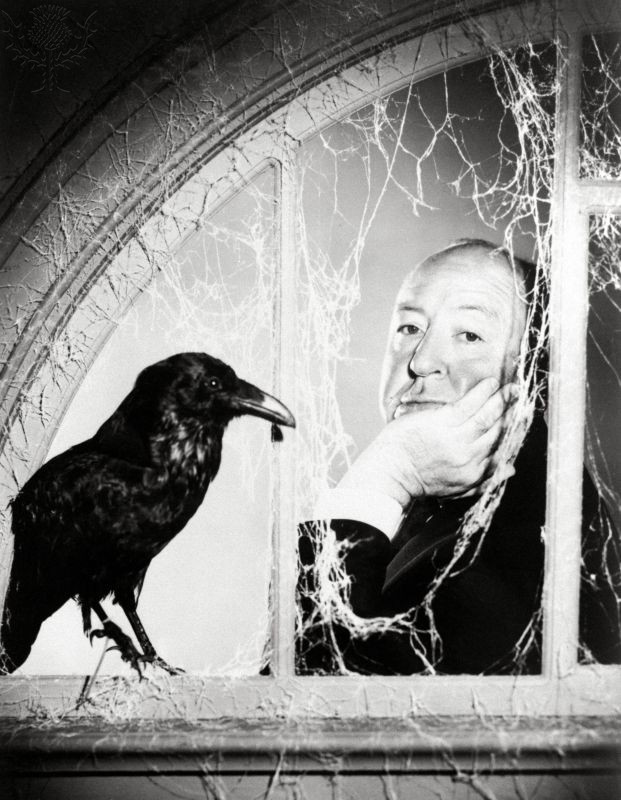
hitchcock with avian friend during the making of “The birds,” 1963
And now, here I am, trying to consider exactly what I’ve seen.
I’ve seen a lot of things.
I’ve seen a man with bloodstained holes where his eyes used to be, another gruesomely stabbed to death in a sleeping blanket, and a group of gangsters moved to tears by a lip-synched rendition of “In Dreams.” More unsettling, I’ve seen Dennis Hopper as both one half of a freedom-chasing, drug-using motorcycle duo and as a sadomasochistic sociopath who gets off wearing a gas mask. Perhaps even more unsettling still, I’ve seen a vulnerable Jack Nicholson (vulnerable? Jack Nicholson?) succumb to the peer pressure of two freewheeling hippies and anxiously take a hit of his first joint.
Needless to say, these movies have left me with a lot on my mind, while 20 years of life and education have left me with an infuriatingly insufficient ability to articulate it all. I’ve nearly finished the course requirements that fulfill my Screen Studies major thus far, and as a result I can critically examine the meaning of certain camera angles, costume decisions, light temperature, and transitions, among other details. I could point out the total absence of non-diegetic music in the soundtrack of The Birds, how horribly the silences enhance the anticipation of impending crowing sounds, how starkly it contrasts with the feel-good road trip playlist of Easy Rider and the recurring nominal theme of Blue Velvet. I could analyze Hopper’s jarring quick cuts back and forth from present to future, scene to scene, and explain how such an unconventional technique underlines how strange the easygoing motorcycle life seemed to the square society surrounding Billy and the aptly and unsubtly named Captain America. And I could talk about how Blue Velvet – well, I wouldn’t even know where to start.
But this is the trouble when movie lovers become film students. Once you are trained in the art of noticing technicalities, the ability to simply sit back and watch a movie slowly but surely evolves into a constant process of interpretation and evaluation, until you suddenly find yourself reading an impossible amount into every romantic comedy and action movie you see with your family, and they all get sick of you asking what they thought because “I liked it” is no longer good enough. Frankly, and from a film student’s unrelenting eye, the movies I watched are so rich with deliberate mysteries, I feel I could write a thesis for each one in an attempt to solve it all – but there is a thin thread tying together my discombobulated train of thoughts. Hanging over my mental rubble is a hazy but discernible smog, an overwhelming and conflicted sense of America.
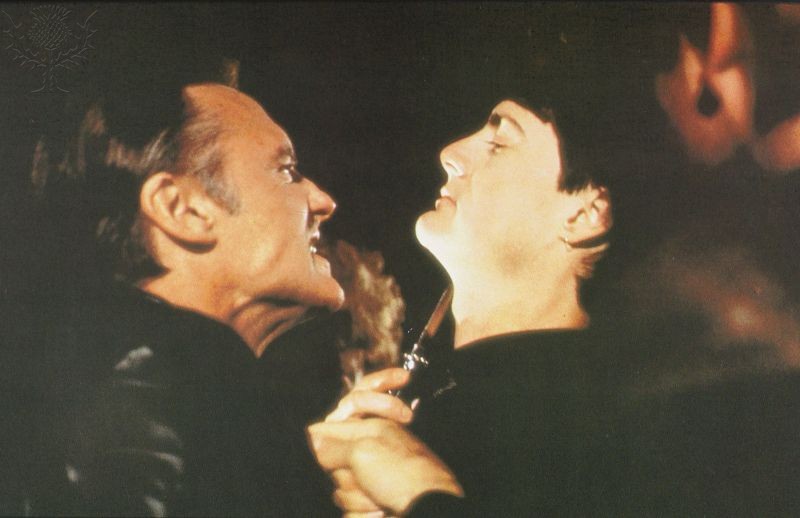
Dennis hopper charms kyle maclachlan
But what else is new, really? On-screen, off-screen – the Americas are the same.
Though these films are aesthetically dated in ways that could never be recreated now without accusations of insincerity or that unconvincing, too-smooth Hollywood glow, I was surprised (I don’t know why) to realize that, in theory, America is just as terrifying as it always has been. Whether I imagined the past or the present as more of a golden age I couldn’t say; I have just always been under the impression that something fundamental had changed between “now” and “then,” but now, I’m not so sure. A while back, I recall posting a rare politically-charged status on Facebook regarding the Supreme Court decision which allows corporations to refuse contraception health coverage, openly wondering how we’ve allowed things to get so unreasonably out of control. (I try to keep these comments few and far between – sooner or later, everyone starts to hate that one person who posts too much of a too-strong opinion). Through my passionately confused, concerned fit of outrage, dulled only by the silent, padded walls of the Internet, I was suddenly reminded of Easy Rider’s tagline: “A man went looking for America. And couldn’t find it anywhere.” Then an image of Blue Velvet struck me, vaguely – white picket fence, green grass, red roses, and all the filth that lives beneath.

dennis hopper and peter fonda in “easy rider”
America. Looking. Can’t find. Anywhere.
It was all so big, I wasn’t sure if the links were truly there or if I had imagined them in a desperate attempt to create some meaning in my stupid life – and then – Godzilla! The Birds! Apocalypse! America! It was there, all there! It was all one horrible, beautiful web of fiction and lies, of myth and reality, of now and then, of me and of them.
What really unites The Birds, Blue Velvet, and Easy Rider, is the responsibility of the individual, and the deeply significant absence of love. Whether or not this is indicative of some universal lack of love for the American Dream is relevant in some ways, but irrelevant in others. Human relationships, whether between Tippi Hedren and her handsome pet store customer, Blue Velvet‘s young hero and his high school lover, or Billy and Captain America, are irrelevant to these stories. While flirtation, sex, and friendship do exist and move the plot, the utter emptiness of these relationships mainly highlight the utter emptiness of these characters and the world they live in – that is to say, America. Things have changed – the specifics, yes (the distinctly eighties hair, the sixties cinematography, the political context, the popular culture) – but what struck a nerve in me was realizing how true these movies still are, and how alone we and you and I often feel in the universal longing to do or make something worthwhile, in this world or in ourselves, asking, is this the way to live?
Perhaps, as it so often happens, I’m reading too much into things. Perhaps I’m a twenty-something cynic, doomed to a life of reading Dostoevsky with troubled, furrowed brows. Or perhaps I ought to buy a pack of cigarettes and Mrs. Wagner’s pies, walk off, and look for something better than the America found here.
Sasha Kohan is a student at Clark University, Worcester, Mass., pursuing a degree in English and Screen Studies.
Photo Credits:
Alfred Hitchcock. [Photography]. Encyclopædia Britannica ImageQuest. Retrieved 14 Jan 2015, from
http://quest.eb.com/#/search/158_2481394/1/158_2481394/cite
BLUE VELVET (1986) – HOPPER, DENNIS; MacLACHLAN, KYLE. [Photography]. Encyclopædia Britannica ImageQuest. Retrieved 14 Jan 2015, from
http://quest.eb.com/#/search/144_1534583/1/144_1534583/cite
EASY RIDER (1969) – HOPPER, DENNIS; FONDA, PETER. [Photography]. Encyclopædia Britannica ImageQuest. Retrieved 14 Jan 2015, from
http://quest.eb.com/#/search/144_1555235/1/144_1555235/cite
0
0
1
124
709
WPI
5
1
832
14.0
Normal
0
false
false
false
EN-US
JA
X-NONE
/* Style Definitions */
table.MsoNormalTable
{mso-style-name:”Table Normal”;
mso-tstyle-rowband-size:0;
mso-tstyle-colband-size:0;
mso-style-noshow:yes;
mso-style-priority:99;
mso-style-parent:””;
mso-padding-alt:0in 5.4pt 0in 5.4pt;
mso-para-margin-top:0in;
mso-para-margin-right:0in;
mso-para-margin-bottom:10.0pt;
mso-para-margin-left:0in;
line-height:115%;
mso-pagination:widow-orphan;
font-size:11.0pt;
font-family:Calibri;
mso-ascii-font-family:Calibri;
mso-ascii-theme-font:minor-latin;
mso-hansi-font-family:Calibri;
mso-hansi-theme-font:minor-latin;}
by Dylan Dodd

ernest hemingway’s high school yearbook photo, 1917 / encyclopaedia britannica imagequest
Your eyes, they show it.
The expression is synthetic.
Raised brow, awkward grin.
Your usual half-smile that
Only shines to the left is not
Proper. Hands folded, one
On the other, no
Bent fingers or spaces between,
Pressed stiffly on a block
With a less than clever “B,”
Made for infants (and picture day.)
You twist your head until
It strains your neck, chin up.
chin up.
This is how people want
To see you, hair solid
With spray, wearing a shirt
That you will never wear again—
Molded clay in a metal chair.
Wait for the click. Relax.
Dylan Dodd studies English at Worcester State University and loves nature, the arts, and the way life works. More of his work my be found at www.dylantdodd.wordpress.com.
by Sam Hark
0
0
1
218
1247
WPI
10
2
1463
14.0
Normal
0
false
false
false
EN-US
JA
X-NONE
/* Style Definitions */
table.MsoNormalTable
{mso-style-name:”Table Normal”;
mso-tstyle-rowband-size:0;
mso-tstyle-colband-size:0;
mso-style-noshow:yes;
mso-style-priority:99;
mso-style-parent:””;
mso-padding-alt:0in 5.4pt 0in 5.4pt;
mso-para-margin:0in;
mso-para-margin-bottom:.0001pt;
mso-pagination:widow-orphan;
font-size:12.0pt;
font-family:Cambria;
mso-ascii-font-family:Cambria;
mso-ascii-theme-font:minor-latin;
mso-hansi-font-family:Cambria;
mso-hansi-theme-font:minor-latin;}
0
0
1
218
1247
WPI
10
2
1463
14.0
Normal
0
false
false
false
EN-US
JA
X-NONE
/* Style Definitions */
table.MsoNormalTable
{mso-style-name:”Table Normal”;
mso-tstyle-rowband-size:0;
mso-tstyle-colband-size:0;
mso-style-noshow:yes;
mso-style-priority:99;
mso-style-parent:””;
mso-padding-alt:0in 5.4pt 0in 5.4pt;
mso-para-margin:0in;
mso-para-margin-bottom:.0001pt;
mso-pagination:widow-orphan;
font-size:12.0pt;
font-family:Cambria;
mso-ascii-font-family:Cambria;
mso-ascii-theme-font:minor-latin;
mso-hansi-font-family:Cambria;
mso-hansi-theme-font:minor-latin;}

Railway Track In The Early Morning Mist / encyclopaedia britannica imagequest
Sam Hark
Goddamnit. It’s now 6 past 7. Trains like dirty tin-can caterpillars
slog inandout of this hollow cocoon of South Street Station.
In front of me a raw flurry of existence flutters by, all glory & madness.
Above me, the footsteps of rain begin their fevered dance, jittering free upon
a slant glass ceiling. Beside me, Sully sits furrowed, lost between the soggy
flaps of an outdated TV Guide (seemingly the last one in existence).
Which (most likely) prompted the existential query that caused his
eyes to bloom like the dusty wings of a moth as he prodded:
if ya could, wouldja’ wanna even know the time of your death?
& on the usual day, one unlike the one I am describing to you here, I would
respond without breath. For I would live out my pre-counted days as the glut King of
Certainty, swilling my red wine from the grandest of goblets like it was rainwater, lazing
upon my gilded throne, gazing with pity upon peasants toiling in muddied fields of
mortality beneath my golden heel. I would tick through this prescription of time as the
sure-sighted surgeon of ephemerality, the true scourge of all obscurity.
But as I previously stated (please see above), this day was unlike the
others that stack higher than an infinite pile of unused TV Guides.
On this day, as the rainwater softly fills my worn boots,
can I come to realize the distinctive grace in the wait for a train
that is all too certain to arrive.
Sam Hark studies English and Philosophy at Assumption College, Worcester, Mass. His influences are John Hodgen, Gregory Corso, Arthur Rimbaud, and Tony Hoagland.
0
0
1
1354
7718
WPI
64
18
9054
14.0
Normal
0
false
false
false
EN-US
JA
X-NONE
/* Style Definitions */
table.MsoNormalTable
{mso-style-name:”Table Normal”;
mso-tstyle-rowband-size:0;
mso-tstyle-colband-size:0;
mso-style-noshow:yes;
mso-style-priority:99;
mso-style-parent:””;
mso-padding-alt:0in 5.4pt 0in 5.4pt;
mso-para-margin:0in;
mso-para-margin-bottom:.0001pt;
mso-pagination:widow-orphan;
font-size:10.0pt;
font-family:”Times New Roman”;
border:none;}
by Kieran Sheldon
Two years ago, yearning to relieve the monotony of a four-day family road trip, I happened upon a novel entitled The Strange Affair of Spring-Heeled Jack by Mark Hodder. According to the synopsis on the back, Sir Richard Burton, Victorian-era explorer and agent of the Queen, was heading into Victorian London’s slums in search of arch-criminal Jack. The synopsis seemed interesting enough, and the cover involved some sort of interesting stilt-walking figure wreathed in blue lightning, so I bought it.
I’d visited London before, and thoroughly enjoyed it. However, real-world London had nothing on Hodder’s version, which was populated not only by the expected lofty lords and cursing cabbies, but also by genetically engineered werewolves, clockwork automatons, and a man who had transplanted his brain into an orangutan. Colossal airships blotted out the sun. Historical figures had been somewhat modified. For instance, in Hodder’s London, Isambard Kingdom Brunel, Victorian-era engineer, survived beyond his presumed death in an enormous steam-powered mech-suit. Somehow, I don’t suspect that the real Brunel accomplished such a feat.
Oh, and as it turns out, Spring-Heeled Jack was a time-traveller.
I had next to no idea what I was reading, but I loved it. Through blind luck, I had stumbled upon steampunk.
Well, consider my monotony relieved.
As a literary genre, steampunk involves the fantastical juxtaposition of the technology and beliefs of the Victorian era with those of today. This anachronism results in such contraptions as clockwork robots and galleons that hover on the aether. Mike Perschon, Professor of English at MacEwan University, proposes on his blog, The Steampunk Scholar that steampunk is characterized by three things: technology powered by dubious or unexplained science, a Victorian-era aesthetic, and an exploration of how the men and women of the past imagined their future. Thus the clockwork robots, and much else.
Steampunk also influences fashion and art. Designers incorporate Victorian garments and airship goggles into their outfits, while artists build modern relics that echo the magnificence of the past. For instance, renowned steampunk craftsman Jake von Slatt modified the pictured guitar by electrolytically etching cogs onto its faceplate.

jake von slatt and his steampunk guitar / jake von slatt
However, when steampunk bleeds beyond the written word and into other cultural phenomena, such as fashion, music, or art, its definition quickly grows less distinct. Primarily, this stems from steampunk’s appeal to those countercultural souls who actively defy definition. Many who incorporate steampunk elements into their artwork do so as a rebellion against popular culture. Therefore, as soon as popular culture begins to understand the steampunk movement, its adherents change its definition.
At first, I was a bit put off by steampunk’s emphasis on rebellion, which had always seemed destructive and ugly to me. However, I came to find steampunk’s take on rebellion fascinating, because it focuses not on destruction, but creation. Steampunk artists, designers, and musicians declare their disdain for some facet of modern culture not by tearing it down but by designing something new and beautiful to take its place. These artists are often referred to simply as “makers,” and for good reason, since they build fantastical devices the likes of which this world has never before seen.
Perhaps most visibly, steampunk rebels against the impersonal nature of modern technology. Many steampunk artists find themselves dismayed by the mass-produced, homogenized gadgets that fill modern markets. Goggles firmly in place, these adventurous souls construct the personalized, artistic technology that they wish was more prevalent in the world. Thomas Willeford, a maker who works mostly in leather, and who built the marvelous ornithopter backpack pictured, points out that “something can be very functional and still have a sense of beauty about it. Where are the wood-grain laptops? Where are the beautifully picture-framed monitors that are commercially available? The monitor is made from induction-molded plastic. It wouldn’t be that much harder to make it look better.”

THOMAS WILLEFORD’S ORNITHOPTER BACKPACK / JESSE WALKER
Steampunk also objects to modern technology’s mechanical incomprehensibility to the average man or woman. In the Victorian era, most technology, involving nothing more than pressurized air and cogs, was understandable without years of specialized study. Williford explained that, instead of presenting iDevices and laptops that seem almost magical in their cryptic operations, “steampunk likes to say, ‘Here’s how our science works. See this steam engine here?'”
The leatherworker bemoans our age’s lack of practical know-how. “I find the inability of people to use tools to be rather abhorrent,” he said. “It is the opposite of being self-sufficient and self-powered. The ability to use tools makes one better prepared for adversity.”
Steampunk suggests a single solution to these many issues: build the type of technology that you want to see in the world, and build it with your own hands. Through this experimentation with technology, often referred to as “tinkering,” steampunk devotees not only make themselves more mechanically knowledgable and capable, but simultaneously create art. Thus, again, the movement eschews the destruction of the unsatisfactory in favor of the creation of something better.
Wearers of steampunk fashion act in a similar manner, casting aside modern dress in favor of top hats, vests, goggles, corsets, and all manner of brass bits and bobs. Styles range from simple hats and vests to such gloriously inconvenient contraptions as Willeford’s ornithopter backpack. Disappointed with the ripped jeans and brand-name sweatshirts of today? Why not wear the sophisticated suits and gowns of yesterday? Some steampunk devotees do just that, while others wear clothing inspired by the practical, utilitarian garb of the Victorian-era worker, the better to hold all of their tinkering tools. Once again, steampunk advocates the creation of a fantastical Victorian-inspired alternative to a less-than-fantastical aspect of modern life.

Mark Eliot Schwabe, a “SteamSmith” / Mark Eliot Schwabe
Mark Eliot Schwabe, a “SteamSmith” who designs intricate metal brooches and charms with airship motifs, contends that steampunk also encourages rebellion through sheer politeness, in an echo of the refined etiquette of the Victorian age. Schwabe notes that one of the reasons he was attracted to steampunk was that when he first encountered it was that, in those days, “our American society was not as well-mannered as it is, actually, now. People were all too frequently in your face. And Victorian manners were a refreshing alternative to that.”
Willeford also objects to modern rudeness, which, he said, is too often passed off as harsh honesty. “Bludgeoning people with ‘honesty’ is rude and, worse, it’s lazy,” he said. “When you take the time to be polite to the people around you, you are telling them that they are worth that time.” In this way, Steampunk combats modern rudeness through imitation of the manners of a more refined age, another of its anachronistic solutions to the less pleasant aspects of modern life.
Not everyone is persuaded of Steampunk’s cultural significance. English professor Mike Perschon, who teaches at MacEwan University in Edmonton, Alberta, Canada, claims that the ethos of steampunk culture has strayed from that of steampunk literature, which does not often incorporate the same countercultural ideals. He also believes that other forms of steampunk do not have the significance that many devotees attribute to them. While studying the genre, he far more often encountered “steampunk that just wanted to tell a ripping good yarn” than steampunk advocating countercultural ideals. In addition, while some members of the steampunk community see steampunk as a statement that “we’re disillusioned with the iPod world we inhabit,” when he has visited steampunk conventions, he has noticed fans toting “a lot of iPods.”
“Steampunk won’t change the world,” he said. “People will.” He alluded to a story Jake von Slatt had shared with him about some steampunk friends of his who volunteered repairing bicycles in Africa. “That’s world-changing,” Perschon said. “But as I understand it, none of them were dressed in goggles or top hats when they did it. “

airship brooch / MARK ELIOT SCHWABE
Maybe steampunk won’t change the world on its own, but it might just point the world in the right direction. After all, making our society more individualized, polite, and self-sufficient certainly qualifies as a noble cause. Certainly, the modern world proves far superior to the Victorian era in many ways, but perhaps the turning of the years has taken something away from us, too. Perhaps too much of our technology and culture has become, in the words of Schwabe the SteamSmith, “same-same.”
“I think many people worldwide have felt the need to individualize and personalize and customize objects and experiences,” Schwabe says, “and steampunk is an excellent vehicle for doing just that.”
0
0
1
50
291
WPI
2
1
340
14.0
Normal
0
false
false
false
EN-US
JA
X-NONE
/* Style Definitions */
table.MsoNormalTable
{mso-style-name:”Table Normal”;
mso-tstyle-rowband-size:0;
mso-tstyle-colband-size:0;
mso-style-noshow:yes;
mso-style-priority:99;
mso-style-parent:””;
mso-padding-alt:0in 5.4pt 0in 5.4pt;
mso-para-margin:0in;
mso-para-margin-bottom:.0001pt;
mso-pagination:widow-orphan;
font-size:12.0pt;
font-family:Cambria;
mso-ascii-font-family:Cambria;
mso-ascii-theme-font:minor-latin;
mso-hansi-font-family:Cambria;
mso-hansi-theme-font:minor-latin;}
Kieran Sheldon admits that he is a bit odd. His myriad pastimes include playing nerdy board games, wearing top hats, and growing carnivorous plants. He also writes a good deal of fantasy and science fiction, but never without his trusty pirate squid, Cal, at his side. He is a junior at Bancroft School in Worcester, Massachusetts.
0
0
1
1879
10714
WPI
89
25
12568
14.0
Normal
0
false
false
false
EN-US
JA
X-NONE
/* Style Definitions */
table.MsoNormalTable
{mso-style-name:”Table Normal”;
mso-tstyle-rowband-size:0;
mso-tstyle-colband-size:0;
mso-style-noshow:yes;
mso-style-priority:99;
mso-style-parent:””;
mso-padding-alt:0in 5.4pt 0in 5.4pt;
mso-para-margin:0in;
mso-para-margin-bottom:.0001pt;
line-height:200%;
mso-pagination:widow-orphan;
font-size:12.0pt;
font-family:”Times New Roman”;}
by Nick Porcella
Last summer I decided I would stay in my college town of Worcester, Mass, rather than return home. I picked up a job in Admissions and an internship at the Worcester Art Museum, and, for the first time in my life, I found myself on a nine-to-five, Monday-through-Friday schedule. The weekends were mine. Work ended at 5 p.m. on Friday and did not require my attention until 9 a.m. Monday. No homework. No appointments. I remember that first weekend kicking around my apartment, unsure of what to do with myself.
“Get used to it,” my Dad said, laughing. He’s been doing this for decades.
The profound realization that I was about to begin seeing a whole new kind of freedom was disconcerting. I felt like a domesticated eagle being pushed out of its cage and into the wild for the first time. What exactly was I supposed to do?
The next Saturday, I opted for change. I had a list of tucked-away used bookstores within one gas-tank’s driving distance. For the remainder of the summer, I decided, I would take one of my days off and just drive somewhere. Drive and find books, sit in coffee shops, see things.
My first trip was to Montague, Mass, which had a highly rated used bookstore called the Book Mill. Sixty miles away and on country roads—they seemed like country roads to me—I decided I would spend three hours of round trip travel to go to a bookstore.
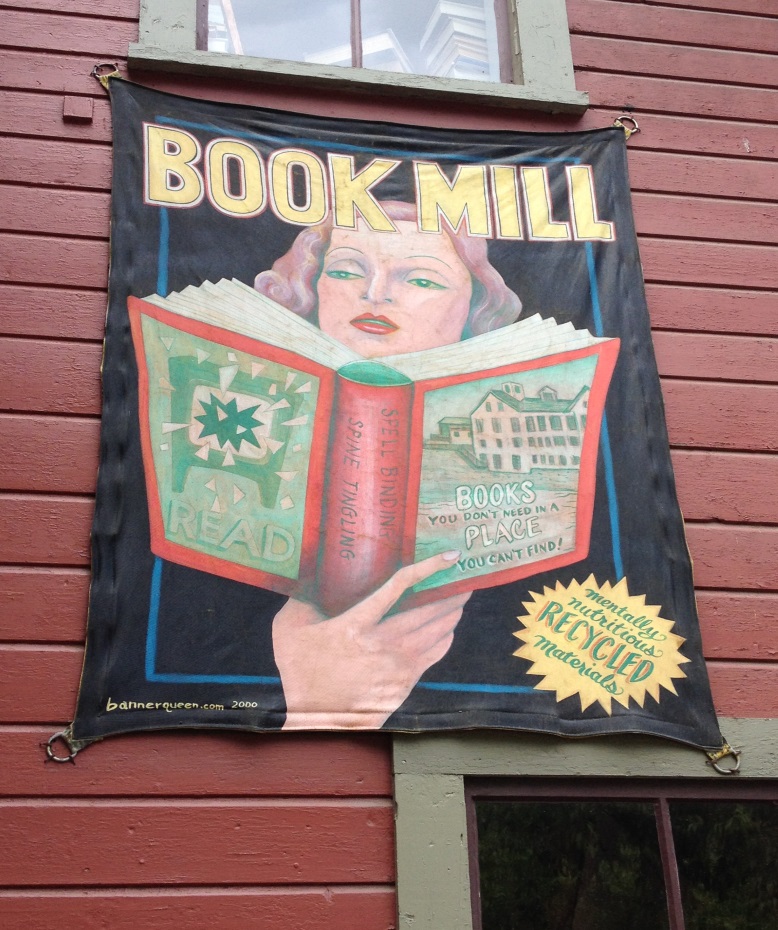
nick porcella
Though their slogan read “Books you don’t need in a place you can’t find!” I found them. Challenge complete! The Book Mill was a complex of different shops. There was the main book shop, yes, but also two restaurants, a music store, and an art gallery. All of the buildings, which were a part of the 1834 Montague Mill, overlooked the waterfall that gave the Millers Falls segment of town its name.
The place was brilliant. I loved the cozy atmosphere and the well-organized, diverse assortment of books. I spent some time in the Classics section, followed by Art (I always save Fiction and Literature for last). There were seats that encouraged people to sit down and read, and I found the perfect spot overlooking the waterfall. I sat and read a long while. It was one of those rare days where I actually thought I had a better time wandering lonely as a cloud. I hadn’t told anyone about my journey.
My pleasurable loneliness didn’t last long. The pictures of Montague that I posted online were a hit, and pretty soon I had friends wanting to tag along on a book adventure. A few weeks later I picked a random Sunday (it turned out to be Father’s Day—sorry, Dad) to visit the Book Barn in Niantic, Conn. My friends Margaret and Zena joined me for the car ride down I-395.

nick porcella
The Book Barn was broken up into four sections, each with a different flavor: Midtown, Downtown, Annex, and something called Store 4. We began at the Midtown store. Midtown alone impressed, almost to a scary degree when we realized that the Annex was even bigger. This Midtown section was a maze!(ing). Books in nooks in corners—everywhere! Midtown had tens of thousands of books, maybe even a six-figure book selection. And this was just one store of four? Score! More! Books galore!
We decided that any store with such obscure sections as Glass Collecting and Dinosaurs for Youth would contain many hidden gems. So, we paid for what we had accumulated from Midtown, dropped the first load at the car, and proceeded to the Downtown Book Barn. We bought more books there and then made a stop at Lollipops and Gumdrops, where we ordered old-fashioned milkshakes and ice cream, and, with a sugar-boost and rested legs, continued our book shopping adventures.
We ended the day at the Book Barn Annex, the largest of the four sections, where we found hundreds of thousands of books spread over several buildings in a complex. By the end of the day we were punch-drunk from staring at books for hours and none of us had the stomach for Store 4. We left with a trunk full of books.
Everything had worked out absolutely perfectly, we agreed. We had found the place and we had shopped for hours.
We ended our summer of book trips by heading out to Northampton. Zena joined me for this trip, as well.
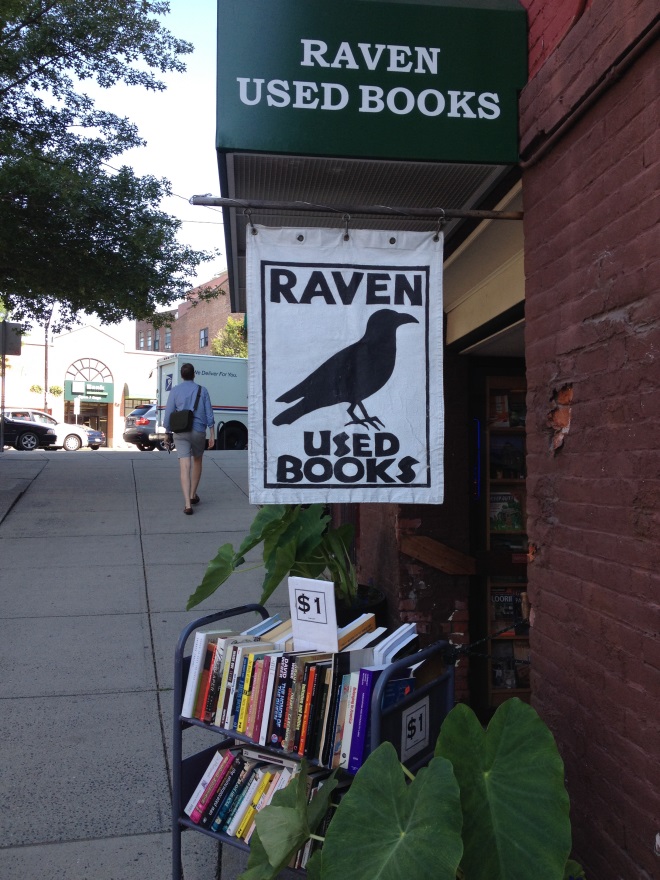
nick porccella
The long day of book-looking began at Raven Book Store. By now, we felt like experts. We were no longer surprised to find tens of thousands of books lining miles of shelf space. We no longer were shocked to be in aisles wide enough for only one set of shoulders. We also became more selective, especially knowing that there were at least a half-dozen other stores to visit. So at Raven, as well as at the next stop, the Old Book Store, neither Zena nor I bought anything. Each store probably had 30,000 used books. Each was entered through lower level basement-type doors. But for me at least, I was like a spoiled child: I had seen this all before.
Then there was Gabriel Books; or, the place that spoiled me all over again. Walking down Main Street past myriad sculptures, farmers markets, coffee shops, and young couples—indeed, all some of the things that make Northampton so spectacularly rich a community—we found Market Street. A few hundred feet down Market was Gabriel Books. A small store absolutely packed with goodies, Gabriel’s boasts an excellent selection of literary fiction, history, and rare finds, all packed in. We could hardly turn in the aisles.
Very close to Gabriel Books we found Metropolitan Used & Rare Books and Records, amusingly located at 9¾ Market Street.
After lunch, we took a short ride to Hadley, which borders Northampton. There was one book store in the area, Grey Matter Books. There was no website for the place, but we figured we would give it a try.
We headed down Main Street towards Hadley. About three miles or so later we saw two small blue signs, one reading “Grey Matter Books 2/10 Mile” and the other “Troubadour Books 2/10 Mile” as well as directional signs pointing us left at the next set of traffic lights. We turned left and held our breath.
We could not find the place. East Street seemed nothing but farm land. After driving up and down several times, we saw a small red sign through the trees. This led us to a one-lane dirt road and then to a big red barn, and there it was, under a canopy of verdant trees. No wonder the guide book reads, “We apologize in advance for any difficulty in finding us.”
Inside we found the single greatest place in the history of humanity. The music in the background was hypnotic, a mixture of tingling indie music. There were sections like Books of the Weird and even Hypnosis. There were rare books, first editions, and signed books. And since Troubadour Books and Grey Matter Books had evidently merged, there were two sections of everything.
The Melville selections were particularly impressive, and I bought almost everything they had, as well as a first edition printing of J.D. Salinger’s Raise High the Roof Beam, Carpenters and Seymour: An Introduction. The guy at the register gave me a 10% discount. I could have spent much, much more.
At this point, Zena and I were beginning to droop, but we had had too much success to quit now. Driving back towards Northampton, we went the opposite direction on Main Street to get to our penultimate book stop. In Bookends Bookstore, I managed to find the exact edition of a book I needed for a class, brand new, yet cheaper than any used copies I had seen online.
And finally to our last stop, which was in Easthampton. Finding White Square Fine Books and Art, we parked on the narrow main street and headed inside. This bookstore was more upscale in décor than the other stores, but the prices were still reasonable. Paying for my 1892 copy of Melville’s Omoo, we left just before they closed around five o’clock.
We strolled down the street to check out the scenery and were rewarded with the sight of a beautiful mountainside overlooking a deeply green landscape that included a pond. This view was a cherry on top of the sweet, sweet day. We also found a quirky sculpture of a bear on which were painted dozens of fish. What an odd creation. We called it a day and got on the road. And so ended our book odyssey.

nick porcella
0
0
1
53
303
WPI
2
1
355
14.0
Normal
0
false
false
false
EN-US
JA
X-NONE
/* Style Definitions */
table.MsoNormalTable
{mso-style-name:”Table Normal”;
mso-tstyle-rowband-size:0;
mso-tstyle-colband-size:0;
mso-style-noshow:yes;
mso-style-priority:99;
mso-style-parent:””;
mso-padding-alt:0in 5.4pt 0in 5.4pt;
mso-para-margin:0in;
mso-para-margin-bottom:.0001pt;
mso-pagination:widow-orphan;
font-size:12.0pt;
font-family:Cambria;
mso-ascii-font-family:Cambria;
mso-ascii-theme-font:minor-latin;
mso-hansi-font-family:Cambria;
mso-hansi-theme-font:minor-latin;}
Nick Porcella studies English at Clark University, Worcester, Massachusetts, and intends to teach high school. His interests include Herman Melville, rap music, photography, and writing. He is completing a memoir, Getting to Say Goodbye. See more of his work here.
0
0
1
738
4210
Boston College
35
9
4939
14.0
Normal
0
false
false
false
EN-US
JA
X-NONE
/* Style Definitions */
table.MsoNormalTable
{mso-style-name:”Table Normal”;
mso-tstyle-rowband-size:0;
mso-tstyle-colband-size:0;
mso-style-noshow:yes;
mso-style-priority:99;
mso-style-parent:””;
mso-padding-alt:0in 5.4pt 0in 5.4pt;
mso-para-margin-top:0in;
mso-para-margin-right:0in;
mso-para-margin-bottom:10.0pt;
mso-para-margin-left:0in;
mso-pagination:widow-orphan;
font-size:12.0pt;
font-family:Cambria;
mso-ascii-font-family:Cambria;
mso-ascii-theme-font:minor-latin;
mso-hansi-font-family:Cambria;
mso-hansi-theme-font:minor-latin;
mso-fareast-language:JA;}
by Thomas Matthews
“You heard we were a good band; well, you didn’t hear it from us.”
So sings Brian Warren, front man of the San Diego band Weatherbox, on “Pagan Baby,” a track from the band’s 2014 release, Flies In All Directions.

Triple crown records
Cocky? Coy? Disingenuous? Who can say? But it’s true, and this latest album proves it.
Weatherbox is most often labeled a “punk rock” band, but the loosely used label doesn’t do the band justice. While Weatherbox most certainly has punk roots, they blend a wide variety of styles into their unique sound, which ranges from the mellowness of the acoustic to blistering, chaotic rock, and even some synth-rock (see ‘Bathin’ In the Fuss’). Over it all hover Warren’s introspective, sometimes brooding lyrics.
Weatherbox has never had a solid lineup. With constantly changing band members, Warren has done the grunt work of structuring and writing all the songs, and just filling in the gaps with people who can play his songs, which demand experienced, advanced musicians.
Flies In All Directions is a great display of the band’s versatility. The album opens with pop-punk anthem “Pagan Baby,” a jam-packed, two minutes and twenty-eight seconds of tight, relentlessly loud rock. After just one listen to this song you’ll be sure to conjure plenty of dirty, confused looks in response to your singing along to lyrics: “It’s such a nice day, let’s stay inside/ it’s such a nice day; we’ve got a lot of time/ nice day.” Warren sings seemingly senseless lyrics as catchy as anything by McCartney or Springsteen.
Warren uses his lyrics and music as a sort of therapy to flush out the demons of mental health that he has had to overcome.

brian warren / triple crown records
He details this in an article in MTV’s Buzzworthy: “I was convinced of awful delusions,” he said, referring to the time their first album, American Art, was released. He hallucinated about “men in disturbing prosthetics, caricatures of my friends but with sharp teeth and arched eyebrows. At another point I thought I was a ghost a million years in the future, where a holographic overlay of 2006 obscured reality and a semi-hostile robotic intelligence had replaced all of humanity.” In an interview with Interview Magazine he described his delusions as part of a series of intense nervous breakdowns he began to have while making his second album, The Cosmic Drama.
As to Flies In All Directions: “This record is taking all of those delusions and making a storyline that’s positive.”The epiphany came after a nervous breakdown he suffered in 2009. “I was at this party standing there, it probably didn’t look like much, but in my head all the years of delusions sort of coalesced into this one story,” he said.
Warren tried to communicate the torment of psychosis in his interview with Interview Magazine: “it’s weird because I’d have to explain psychosis, which is a really hard thing to do. All these delusions are created and then the psychotic mind can easily shove them into this one category.” His lyrics seem better suited to express the feeling of being plagued by hallucinations and psychosis. In “The Fresh Prints of Bill Ayers” he sings, “And I received a deleted memory of you and me/ On the run from a team of sickening police forever/ We used to have such fun together/ Do you remember?”
But it’s not all about Warren and his struggles. On the album’s captivating closing song, “Love Me A Good Microcosm,” he sings: “Cause you can glorify the Old Pages and be responsible for the New Cages/ Or you can say ‘to hell with me’ and you can get creative,” detailing the damaging effects obeying dated religious texts have on society, including the loss of critical thinking.
Weatherbox has made a triumphant step forward in the evolution of its sound with Flies In All Directions. We see the band tackle thirteen tracks and craft each with precise attention to detail. Warren told Interview Magazine he even took some classes on using audio software so he could communicate in the studio the exact sound he wanted. Did it pay off? I would say yes, definitely. While the metaphorical lyrics and abrasive, dark tones of songs like “The Drones” and “Ghost Malls” may be hard for the unfamiliar listener to get into, the album has plenty of welcoming songs as catchy as those of any indie/punk/pop/rock band.
You can buy the album from Triple Crown Records here
Below, listen to “Bring Us The Head Of Weatherbox” and watch “Pagan Baby” performed live at Audio Tree Studios, both from Flies In All Directions.
[soundcloud url=”https://api.soundcloud.com/tracks/138422754″ params=”visual=true&show_artwork=true&callback=YUI.Env.JSONP.yui_3_17_2_1_1420745416557_7697&wmode=opaque” width=”100%” height=”400″ iframe=”true” /]
[youtube=://www.youtube.com/watch?v=jxVdKHvhAr0&w=854&h=480]
Contributing Editor Thomas Matthews studies English at Clark University.
Follow @writtenbytom !function(d,s,id){var js,fjs=d.getElementsByTagName(s)[0],p=/^http:/.test(d.location)?’http’:’https’;if(!d.getElementById(id)){js=d.createElement(s);js.id=id;js.src=p+’://platform.twitter.com/widgets.js’;fjs.parentNode.insertBefore(js,fjs);}}(document, ‘script’, ‘twitter-wjs’);
by Julia D’Arcy
0
0
1
849
4845
WPI
40
11
5683
14.0
Normal
0
false
false
false
EN-US
JA
X-NONE
/* Style Definitions */
table.MsoNormalTable
{mso-style-name:”Table Normal”;
mso-tstyle-rowband-size:0;
mso-tstyle-colband-size:0;
mso-style-noshow:yes;
mso-style-priority:99;
mso-style-parent:””;
mso-padding-alt:0in 5.4pt 0in 5.4pt;
mso-para-margin-top:0in;
mso-para-margin-right:0in;
mso-para-margin-bottom:8.0pt;
mso-para-margin-left:0in;
line-height:107%;
mso-pagination:widow-orphan;
font-size:11.0pt;
font-family:Calibri;
mso-ascii-font-family:Calibri;
mso-ascii-theme-font:minor-latin;
mso-hansi-font-family:Calibri;
mso-hansi-theme-font:minor-latin;}

The Worcester Journal
Most things unfold gradually, and at times the unfolding is beautiful, like that of a flower bud. At other times, it just hurts. Watching you slowly slip away from us is like saying goodbye to you every day. The pain never ends. Not that I would want it to.
There are so many things I would say to you if you could understand. I say them anyway, holding onto the tiniest sliver of hope that one day everything will click again, that the broken puzzle piece will repair, itself and you’ll be yourself once more, cracking jokes constantly and telling me a war story for the thousandth time.
I’d rather hear the story about nana making a blueberry pie. Nana was trying to impress your parents the first time she met them and tried to make the perfect pie, only to forget the sugar. Your words paint the priceless expression on your father’s face as he took the first bitter bite. The story always left everyone in hysterics.
Why is it that some things stick with us like that? The simplest story becomes a staple for conversation and a filler of silences, told for half a century without becoming tiresome. Other things pass us by like autumn leaves in the wind, never to be thought or spoken of again.
Most things are autumn leaves for you these days.
I can’t quite remember when it started. There was no distinct first time. Not like the first time a baby walks, the first day of summer, or the first sentence a child reads. It occurred slowly with no clear beginning. It just all happened. One day you were your regular self. And then you couldn’t remember certain details or facts. And then you had episodes. Fits of rage and confusion. They were after you. The nurses were cops, foreign soldiers, or some other enemy. And now, well, now I’m not sure if you even know who I am. On the good days I am the girl with the car; you ask, “Can you take me out of here?” On the bad days–I don’t know who I am on the bad days.
I don’t remember a beginning, but I do remember the first day I visited you in the hospital. You’d been there before, hip and knee surgeries mostly, but this time was different, somehow. I could feel it when I walked into your room. We talked about the simple things at first: the weather, the view from your window, how I was doing at school. You struggled for words, while I did most of the talking. And then I found the light switch. The war. I don’t remember how or why I brought it up but bam, there it was, the key to conversation. Once you started going I couldn’t stop you, and I loved every second of it. Somewhere in your mind, you found the pieces of memories and stuck them together. I felt bad when I had to leave but I feel worse now that I know that was the best day there would be left.
If I listen close enough, I can hear you telling my favorite war story. You and your buddies were nearing an island and, being the curious guy you still are, you wanted to see the islanders. There was just one problem, there weren’t enough binoculars to go around. That, however would never stop you. You quickly realized that you could use the scope on your gun to better see. You failed to realize that this would alarm the villagers and send them into a panic.
I’m not really sure why that one’s my favorite, but it always made me laugh uncontrollably. Maybe it’s because while other people only see the harm and pain in war, you found the humor. You never have once told me a sad war story. Even the ones in which people die contain humor. You’d get that look in your eye and say flatly, “he died,” before glossing it over with humor or moving on to the next story, never dwelling too long on the sadness none of us wants to focus on.
Now, you’re in a constant state of confusion. I wonder what year you’re in. Sometimes it’s in the 1940’s and other times the present. I wish I knew who you think I am. You’ve lost a lot, but the one thing you hardly ever lose is your attitude. Sure, sometimes you get frustrated, but who wouldn’t if they were told everything they thought was true is wrong? Most of the time you’re the same cheery, gleeful guy I’ve known since I was born. The one who played Barbies with me on the living room floor, the one who built me a swing set, and taught me to swim. The one who has something to give everyone, even if it’s just a good laugh.
No, there was no distinct beginning or a list of firsts to this period in your life. But there will be a long list of lasts. I see them beginning and I’d give anything to put them on pause, but I know in the end you’ll be happier and freed of your pain. It started with the last day you were aware of what was happening. Then, there was the last day you got out of bed. And, today, today you stopped speaking in full sentences.
As I sit by your side on these days I’m thankful that you taught me your sense of humor. Even in these dark days that connect our family, we laugh. Because how could we make it through if we weren’t laughing with you as you “sew” the ripped thread on your blanket or only say “Hi!” to Amy and ignore everyone else? (I always knew she was the favorite.) Even on these dark days as the green leaves turn orange and red and slowly fall to the ground, you still provide us a ray of sunshine.
You always will.
***
Editor’s Note: William Edward Tormey Jr. passed away on October second 2014 at the age of 91.
Julia D’Arcy studies Communication Sciences and Disorders at Worcester State University in Worcester, Mass., and is working toward a masters in Speech Pathology. She enjoys reading, writing, and the beach.
by Sloane M. Perron

Illustration by Abby Frias
Fingernail marks scratched into the walls, barred windows, and a shadowy figure trapped in the wallpaper trying to escape–Charlotte Perkins Gilman creates a Gothic masterpiece in her short story, “The Yellow Wallpaper.” Written in 1892, this story blurs the line between reality and perception by following the mental unraveling of a woman after she is placed on complete bed rest because of her nervous behavior. Confined in a room, denied recreation of any kind, the narrator is plagued by a ghost-like woman who is trapped in the yellow wallpaper. The story reads like a supernatural thriller, but much of it was actually taken from the “rest cure” that was imposed upon Gilman to treat her postpartum depression.
Indeed, the depictions of postpartum depression and postpartum psychosis in the story are so realistic that Gilman’s work is being used to teach modern psychology to medical students. At the Medical School of the University of Oklahoma, medical students can take a class entitled, “Helping Medical Students Understand Postpartum Psychosis Through the Prism of ‘The Yellow Wallpaper’ by Charlotte Perkins Gilman.” Dr. Phebe Tucker is a specialist in psychiatry and has been a professor at the University of Oklahoma since 1989. She was also one of the faculty members who developed this program, which combines literary analysis with a practical, medical purpose. Dr. Tucker, whose undergraduate degree was in English from the University of Berkley, believes that this form of teaching made the medical studies “more alive” for the students since they were able to directly empathize with a character that has a mental illness. According to Dr. Tucker, the transition from English to psychiatry was very natural. “The humanities blend with psychiatry since everyone has their own narrative,” she said.
The course aimed to reduce the stigma related to mental illness, to analyze doctor-patient relationships, and to teach students to be more empathetic as they experienced the author’s depression and psychosis. Students were also tasked with finding symptomatic “clues” about postpartum psychosis within Gilman’s text. About 160 medical students participated. According to Tucker, “Psychiatry students were receptive to this form of teaching and most were open-minded. However, some students are used to concrete studies and they get frustrated if the course was too abstract.” In order to challenge these students to think creatively, voluntary after school activities were offered. For example, book groups with faculty allowed students from the class to interact with literature and think creatively.
“The Yellow Wallpaper” is an important work because it changed the way that postpartum psychosis, now known as Peripartum Onset Mood Disorder, was treated and publicly perceived. Many psychological disorders with which modern doctors are familiar were largely unknown to Victorian physicians. As a result, terms like “hysteria” and “nervous depression” became all-encompassing diagnoses used for women experiencing anxiety or depression shortly after giving birth. The common treatment for such a state was the “rest cure.” Developed by Dr. Silas Weir Mitchell, the rest cure was a course of treatment in which the patient was instructed to completely relax and to take part in minimal physical activity. The rest cure emphasized isolation. In some cases, women were not allowed to read, write, leave their beds, or even feed themselves.
In 1885, Charlotte Perkins Gilman gave birth to a daughter, Katharine Beecher Stetson. Shortly after, Gilman began to experience extreme depression and was placed on Dr. Michel’s rest cure. As weeks passed, the isolation and physical restrictions amplified Gilman’s symptoms and the inability to write or read stifled her. She had no creative outlet in which she could express herself. She escaped through her vivid imagination, which exacerbated her anxiety and depression. It was only after Gilman refused to take part in the rest cure that she slowly began to show signs of improvement.
Years later, Gilman wrote “The Yellow Wallpaper” in order to show the failure of Dr. Mitchell’s treatment. The story also emphasizes the oppressive and sexist nature of a cure that gives male doctors complete authority while female patients are treated as fragile, emotional beings incapable of making their own decisions.
The narrator in “The Yellow Wallpaper” integrates Gilman’s real life experiences with the drama and terror of a Gothic novel. The woman in the story arrives at a beautiful mansion that she and her husband, John, are staying at for the summer in hopes that she will overcome her “nervous condition.” John, who is a doctor, places his wife on the rest cure and prevents her from taking walks in the garden, writing, or having visitors. With nothing else to do, the narrator contemplates the surroundings of her new room from the barred windows, scratched floor and nailed-down bed, to the hideous, torn yellow wallpaper that covers the walls. As the weeks of complete rest pass, the narrator’s anxiety and paranoia grow as she starts to see the image of a woman in the wallpaper. The narrator shifts from hating the wallpaper to appreciating it as she starts to empathize with the shadowy woman lurking in the paper. The conclusion of the story signifies the narrator’s final break from reality as she becomes the woman in the wallpaper and finally breaks free from the wall and her husband. The damage to the room was actually caused by the narrator as she crawled around scratching the floor and tearing the wallpaper.
According to Dr. Tucker, the medical students who analyzed the story were trained to search for clues that would establish a diagnosis such as the protagonist’s concentration problems, lack of confidence, sleep disturbances, and psychotic elements. As a result, they concluded that in modern medicine the protagonist would be diagnosed with major depression with psychotic features and Peripartum Onset Mood Disorder. Dr. Tucker explained that the disorder typically occurs during pregnancy or during the four weeks following birth. It usually consists of a major depressive episode and can be accompanied by psychotic symptoms. Hormone imbalance is the cause, although some individuals may be born with a genetic predisposition. The narrator of the story also has psychotic breaks from reality. The narrator’s hallucinations of the woman behind bars in the wallpaper, sudden mood swings, paranoid suspicions about her husband and his sister as well as her hyperactivity of tearing the wallpaper and constantly crawling all demonstrate the psychosis. The narrator’s baby is only mentioned once in the story when the narrator says that she wants to be with the baby but that it makes her so “nervous.” This signifies the difficulty a sufferer may have in bonding with her child.
Gilman wanted to share her painful experiences with the public in order to shed light on the harmful results of Dr. Mitchell’s rest cure. In fact, after Gilman published her story, Dr. Mitchell eliminated the rest cure and developed new treatments. In modern psychiatry a combination of medications and therapy would be used to treat the protagonist of “The Yellow Wallpaper.” According to Dr. Tucker, if the protagonist was her patient, she would recommend interpersonal psycho-therapy to help the woman assert herself and develop more confidence, couples therapy to create a more supportive relationship with her doctor husband, support groups, and medication that would help her function on a daily basis. Journaling would be encouraged.
Underneath its Gothic dressing, “The Yellow Wallpaper” tells the candid story of an emotionally unraveling woman whose return to health is stifled by a misunderstanding of psychological disorders and the oppressive patriarchal society of her time.
By revealing her own struggles to the public, Gilman unleashed her own “woman in the wallpaper” and ultimately changed the way that women with postpartum depression were treated.
0
0
1
40
229
WPI
1
1
268
14.0
Normal
0
false
false
false
EN-US
JA
X-NONE
/* Style Definitions */
table.MsoNormalTable
{mso-style-name:”Table Normal”;
mso-tstyle-rowband-size:0;
mso-tstyle-colband-size:0;
mso-style-noshow:yes;
mso-style-priority:99;
mso-style-parent:””;
mso-padding-alt:0in 5.4pt 0in 5.4pt;
mso-para-margin:0in;
mso-para-margin-bottom:.0001pt;
mso-pagination:widow-orphan;
font-size:12.0pt;
font-family:Cambria;
mso-ascii-font-family:Cambria;
mso-ascii-theme-font:minor-latin;
mso-hansi-font-family:Cambria;
mso-hansi-theme-font:minor-latin;}
Contributing Editor and journalist Sloane Perron is a seniot at Anna Maria College, Paxton, Mass., studying English and Business. She will present her Honors Thesis, “The Many Faces of Guinevere,” at Keene State College, Keene, New Hampshire, this spring.
0
0
1
671
3826
WPI
31
8
4489
14.0
Normal
0
false
false
false
EN-US
JA
X-NONE
/* Style Definitions */
table.MsoNormalTable
{mso-style-name:”Table Normal”;
mso-tstyle-rowband-size:0;
mso-tstyle-colband-size:0;
mso-style-noshow:yes;
mso-style-priority:99;
mso-style-parent:””;
mso-padding-alt:0in 5.4pt 0in 5.4pt;
mso-para-margin:0in;
mso-para-margin-bottom:.0001pt;
line-height:115%;
mso-pagination:widow-orphan;
font-size:11.0pt;
mso-bidi-font-size:10.0pt;
font-family:Arial;
color:black;}
by Ajey Pandey

Knife Party, as far as side projects go, has gotten really big. The electronic music act features Rob Swire and Gareth McGrillen, two members of the Australian band Pendulum. They started Pendulum back in 2002 as rock and metal musicians dabbling in computer music, and have since achieved major success with their signature mix of rock and electronic music.
But in 2011 Swire posted a 20-second clip titled “Not Pendulum” featuring a glitchy, rumbling dance track that had more in common with the work of electronic dance music producer Skrillex than his old work. That clip became Knife Party. Since then, the duo has shifted attention from Pendulum to Knife Party, releasing three EPs (four-track mini-albums) that augment the violent, distorted synths of electro house and dubstep with a goofy sense of humor and a love for cheesy sci-fi/horror flicks. If you watched Breaking Bad, you’ve probably heard the Knife Party song “Bonfire,” that wall-shaking love child of reggae and dubstep that graced the fifth season.
You can hear the musicians’ bending and blending of genres in songs like “EDM Death Machine,” which kicks off with, “In the future, nobody will drop the bass / No one will do the Harlem Shake,” then continues by remixing “Sandstorm,” that trance song that has never stopped playing since 1999. And then there’s “Centipede,” which starts with a 40-second clip about giant killer centipedes hunting tarantulas. Yup.
Now the duo is back with a full album, Abandon Ship. And it’s amazing.
About half of the album is classic Knife Party fare, the sort of music that will either get you dancing or give you a headache. At the album’s loudest, heavily processed drums pound out steady, powerful rhythms, meaty synth chords flood your ears, and bass sounds, metal guitars, and robot speech shake down your house. Goofy audio clips dispersed in the music make you laugh as hard as you dance. Imagine Transformers 8: MegaÜber Dance Fight taking place in a haunted house in space, add some lasers, and you’ll have idea of where this album can go.
But not even the most turned-up tracks here stay full throttle all the time. The duo doesn’t shy away from extended interludes where they replace heavy drums and violent bass with smooth, liquid-feeling chords and staccato melodies that bounce around your head like blinking lights on a computer. This occasional mellowness is a good thing, because a perpetual tsunami of sound would drive the heads of all but the most dedicated ravers into the nearest brick wall. That said, every track here is still an all-out dance number, so you may need to stop halfway through the hour of music to catch your breath.
Some of the tracks throw the raging-robot sound out the window, exploring vastly different styles. The first track, “Reconnect,” introduces the album with a cinematic flair somewhere between Star Trek and Pirates of the Caribbean. Then, in “Begin Again,” the musicians return to their roots in Pendulum, with light background synths, blaring trumpets, and Rob Swire belting out cliche yet catchy lyrics. But the most out-there song–by far–is “Superstar.” It’s disco. Sung by Bryn Christopher, the track has all the funky guitars and retro synths your heart desires, and I can’t stop dancing to it.
The album is dotted with little jokes to spice things up. In “EDM Trend Machine,” the duo plays brief pieces of stereotypical rave music, then, with a cartoonish vinyl scratch, cut to a completely different sound. The house track “404” features error-message sounds from decade-old computers. “Micropenis” features a 30-second interlude seemingly ripped out of an NES game and narrated by a text-to-speech generator. And, well, it’s called “Micropenis.”
As Abandon Ship released, Rob Swire tweeted that he was happy just to make it, even if it sold poorly and he and Gareth McGrillen would “have to sell organs for food.” And that shows in the album itself (well, maybe not the organ-selling bit). It’s lovingly crafted, but it’s never too serious not to have fun with.
You can download this album via iTunes, Google Play, or Beatport, buy a CD via the musicians’ site, or stream the entire album for free on their SoundCloud page (https://soundcloud.com/knifepartyinc).
Ajey Pandey is a 12th grade student at Mass Academy of Math and Science, Worcester, Mass. He enjoys writing, making music, and especially writing about music.
by Akriti Sharma

The girl before me has straight black hair, a bob cut with fringes. Her skin is olive and her lips are thin. She is wearing black sunglasses and is motionless. She is seven years old.
“Mero naam Reyhan,” she says.
I look down, and blink, “Your name is Reyhan?” It is a boy’s name.
“Yes,” she says. She stands a bit straighter, maintains a poker face.
I turn to the caregiver in the room to re-confirm; maybe I had misheard. Before I open my mouth, she says, “Yes, her name is Reyhan.” I turn back to the girl, and tell her that I am pleased to meet her. We sit in a circle. There are nine children in the center with my four friends and myself around them. We are volunteers from the local high school.
The caregiver tells us we are to first help the children with their homework before getting to the other activities. Some of the children are older and don’t need help with homework. The younger ones begin playing games without even opening their books.
I am soon sitting with another young girl, trying to figure out fifth-grade science. I notice Reyhan is the only one sitting alone. She is in the corner, silently doing her work. I ask her if she’s okay.
“I’m fine,” she says.
“What are you doing?”
“I’m doing English.” It’s clear she doesn’t want to talk. I give her space.
The caregiver tells me that Reyhan was named Riya by her parents. Pronounced “Ree-yah” but with a dozen different spellings, it is a very common name for Nepali girls.
Reyhan is an uncommon name for Nepali boys. And it is never used for a girl.
The next week, the children are eating in the dining room. One by one, the room empties as the children finish and go to the common room to start their homework. All my friends have gone upstairs and I find myself alone in the dining room with her. Reyhan has finished eating, yet she’s sitting at the table alone. I ask if she wants to come up with me and she answers yes.
“I just have to wash this first,” she says. She navigates her way out onto the back porch where there is a low sink, kid-sized. She is washing her hands when I tell her to join the other children. “I will do your dishes,” I say. “It’s not a big deal.” I reach to take the plate off the sink but she snatches it from me.
“I said I will do it,” she says. “What makes you think I can’t do this myself?”
I apologize. She’s quiet again.
“Please wait for me,” she says.
***
When we join the other children upstairs, Reyhan opens her book to begin her homework; she surprises me by calling my name. “I need help with this,” she says, pointing to a page in her science book.
“Is it question 3?” someone from behind asks. “I don’t understand it either, how are we to answer this?”
I take the social science book from Reyhan’s table and look at it.
Q3. What is the National flower for Nepal? What are its colors and what does it symbolize?
I look up at Reyhan who is running her fingers over the words as she waits for my response. My throat has a lump. I don’t know how to handle the situation.
“Well, our national flower is the…” I begin.
“The laliguras, I know that,” Reyhan interrupts, referring to the Nepali term for rhododendrons. “But what are the colors?”
I glance at my friends, who look as dumbfounded as I feel.
“I heard they are rato,” a little boy from the other end of the room answers.
“Yes, he’s right, they are red,” answers another girl. “I read it in a book”
“Rato” Reyhan repeats, the Nepali word for red. “I can’t remember, what does rato look like, Akriti?”
I scramble for words I can’t find. The caregiver enters the room. “Red is the color of festivals,” she says, smiling pleasantly. “Now please stop getting distracted and finish your homework so you’ll have more time to play.” She turns to me and takes the book from my hands. “Do they really have that question in here?” she asks rhetorically. “What the hell were they thinking?”
That evening, after my friends and I say our goodbyes, we walk the fifteen minutes to the bus stop in silence.
***
I volunteer at the blind children’s rehabilitation center. The students there are independent with a passion for life. They teach me more than I teach them. Science and math and English can all be learned. I’ve read books with the same descriptions of the solar system in English and Nepali. And in braille. I’ve run my fingers over the same content in braille while these children sat doing their homework. Knowledge is available to anyone willing to learn.
I am lost as to how to describe this little girl. Once, when she was using her pointed stylus and slate to punch out letters in braille, I saw her prick her little fingers over and over, but she kept going. Persistence. When she fell in front of me, she refused to let me help her up. Independence.
Entering a room, she could recognize me by my voice, and even sense my silent presence there. I marveled at the resilience of her brain and spirit.
I could not begin to imagine what this child had endured. Reyhan was not born blind. In fact, she had become blind less than two years before.
One afternoon, after the children are done with their homework and after a long game of Telephone, Reyhan asks to touch my face.
As her steady hands cup my face, feeling my nose, my eyes, my forehead, and chin, she speaks: “I used to be able to see. Then I got cancer.” She smiles. “That’s why I wear these.” She gestures at the sunglasses she always wears.
“I’m forgetting what I look like,” she whispers, frustration in her voice. “How do I look?”
I tell her that she has straight black hair, fringes typical for a girl her age, and a little bob cut. That she has an olive hue to her complexion that gives her a nice glow, that she possesses a very nice smile, that she is a pretty young girl.
“I’m not a girl,” she said. A bit too loudly. “And I’m not pretty.”
Before I say anything, she gets up and storms off. I don’t see her for the rest of the afternoon. At home that night, I ask my father, an oncologist, what kind of cancer could turn a young child blind.
Retinoblastoma, he says, is a common cause of blindness in children under five, if not treated early. He explains it to me, but what I really want to know is how I had offended her, and I doubt my father’s copy of Bailey and Love’s Short Practice of Surgery has the answer to that.
***
The following days are routine; Reyhan never brings up the incident and neither do I. The months pass quickly and I am accepted into college. Soon it is time for us to say good-bye.
My friends and I decide that before we leave we will bring some toys and gifts for the children. They must have known we wo
uld do this, since later that evening, as we were walking out, they yelled, “Don’t forget us!”
It only struck me then, that these gifts—the hair clips, spinning tops, dolls, marbles—were to the children reminders of the many 16-year-old volunteers who come and go in their lives.
That afternoon, I buy a pack of hair clips for the seven girls in the group. One of them had said they liked the hairpin in my hair. I let them feel all of the clips and pick out the ones they want. Everyone but Reyhan has clips now and they begin braiding each other’s hair and giggling. I go to Reyhan.
“Would you like a clip?” I ask.
“No.”
“Are you sure?” I am tentative.
She shrugs and says okay and asks me to put one in her hair. Her fringes are growing and her hair has grown too. I put two into her hair.
“There, you look really nice now,” I smile, careful not to say something that might set her off.
“Really?”
“Yes, your hair looks really nice like this,” I say. “Maybe you should keep it long, Riya.” I slip. The second I say so, I know I’ve made a mistake. I watch her face contort as she gets up and runs out.
“DO NOT CALL ME THAT. I am NOT a girl, I don’t WANT to be one,” she yells. I don’t expect her to start crying.
I run after her. At her room there is no one. I knock on the bathroom door. No answer.
Outside, the balcony is deserted. I head downstairs, to the common room, when I hear sniffling. Sitting curled up in a ball on the staircase is Reyhan, tears streaming.
“I’m sorry,” I say.
She looks at me.
“I’m sorry,” I repeat. “I didn’t mean to offend you.” I sit on the stairs beside her. She stops crying. “I have an older brother and a mother,” she begins. “I love them very much and they love me. I have a father and I love him too, but I don’t know if he loves me.”
“My father always wanted sons,” she says. “But after my brother … I was born. And it was okay … until I got cancer.”
She’s quiet again and I hear her heavy breathing. The tears come once more.
“It was the first surgery, then the other,” she says. “Then I became blind, and I couldn’t do anything. I became a burden.”
Burden.
I became a burden.
This from a seven-year-old child. It shouldn’t shock me but it does; I have grown up in a country where children with disabilities are considered lucky if they are sent off to boarding schools. This is not always because families reject them. Most often it is because parents can’t afford them.
We sit on the dingy staircase and I try to console her, though my words are meaningless. I know nothing of how she feels, I know nothing of what she’s gone through. I cannot imagine what it must be like to have something that you take for granted snatched away from you. She is distracted now, reminding me she still is a child. Her parents and brother are to pick her up for the holidays in a week. She can’t wait to see her brother.
“I want you to meet him one day,” she says. “He’s my most favorite person on the planet.” I tell her that I will, one day.
That evening while we’re leaving the house, she stops me.
“Akriti,” she says. “I want to ask you a question.”
I smile, “Yes?”
“Will you forget me?” she asks, looking up at me. “Promise me you won’t forget me?” She holds out her hand to touch mine.
I hug her and tell her, no, I won’t forget you, ever.
0
0
1
32
188
WPI
1
1
219
14.0
Normal
0
false
false
false
EN-US
JA
X-NONE
/* Style Definitions */
table.MsoNormalTable
{mso-style-name:”Table Normal”;
mso-tstyle-rowband-size:0;
mso-tstyle-colband-size:0;
mso-style-noshow:yes;
mso-style-priority:99;
mso-style-parent:””;
mso-padding-alt:0in 5.4pt 0in 5.4pt;
mso-para-margin:0in;
mso-para-margin-bottom:.0001pt;
mso-pagination:widow-orphan;
font-size:12.0pt;
font-family:Cambria;
mso-ascii-font-family:Cambria;
mso-ascii-theme-font:minor-latin;
mso-hansi-font-family:Cambria;
mso-hansi-theme-font:minor-latin;}
0
0
1
32
188
WPI
1
1
219
14.0
Normal
0
false
false
false
EN-US
JA
X-NONE
/* Style Definitions */
table.MsoNormalTable
{mso-style-name:”Table Normal”;
mso-tstyle-rowband-size:0;
mso-tstyle-colband-size:0;
mso-style-noshow:yes;
mso-style-priority:99;
mso-style-parent:””;
mso-padding-alt:0in 5.4pt 0in 5.4pt;
mso-para-margin:0in;
mso-para-margin-bottom:.0001pt;
mso-pagination:widow-orphan;
font-size:12.0pt;
font-family:Cambria;
mso-ascii-font-family:Cambria;
mso-ascii-theme-font:minor-latin;
mso-hansi-font-family:Cambria;
mso-hansi-theme-font:minor-latin;}
Akriti Sharma is a senior at Clark University, Worcester, Massachusetts, majoring in Economics. She grew up in Kathmandu, Nepal, and has been volunteering many years. She loves books and dogs, and she greatly misses her two German Shepherds back home.
by Warren Singh
It’s 10 am, and I’m fairly sure that I’m getting strange looks. It turns out that sitting by yourself and alternating pensive looks with hysterical laughter leads to sidelong glances, even if you have a book in front of you.

The book in question is If Ignorance Is Bliss, Why Aren’t There More Happy People? by John Lloyd John Mitchinson, published by McGraw Hill. And the contents are just as amusing as its title, if not more so.
It’s a collection of quotations on various topics by a wide variety of people, from such people as Nobel Laureates Richard Feynman, Marie Curie, and Albert Einstein, entertainment figures like Groucho Marx and Steve Martin, and even Al Capone and Miss Piggy.
Separated into sections by subjects (‘work’, ‘love’, ‘popes’, ‘potatoes’), quotes are placed in no particular ordering scheme, not alphabetically by subject, opening word, or author. Simply scanning the book leads one to believe that it’s not required, or even designed to be read in a linear fashion. For instance, I’ve been having great fun simply opening to a random page and reading whatever is there. Occasionally, this random ordering makes for a delightful incongruity: Samuel Goldwyn’s opinion that a hospital “is no place to be sick” is followed by Victor Hugo defining imagination as “intelligence with an erection.”
The book is like a party favor bag whose contents were provided by the most interesting people that you know. On one page you’ll see Joseph Heller on work: “While none of the work we do is very important, it is important that we do a great deal of it.” or Will Rogers on time: “Half our time is spent trying to find something to do with the time we have rushed through life trying to save.” Turn a few dozen pages back and you’ll see H.L. Mencken on stupidity: “There is no idea so stupid that you can’t get some professor to believe it.”
It’s all quite a hodgepodge, and that’s what I find so charming about it. Collecting quotes is like meeting interesting people and only hearing the most amusing or insightful things that they have to say. It’s ambrosia for my brain. Before, I’ve only dabbled in quotations recreationally, but with the addition of this book, it’s developed into a full-blown habit. Someone call the paramedics, because this volume is getting mainlined.
The fact that there are contradictory quotes all over doesn’t bother me; two quotes on the same page might directly cancel each other out, and I still enjoy both of them. It’s probably because I just like having my think bone tickled, and this tome is quite the thwack. I’m laughing, thinking, and then laughing some more.
If any of this sounds appealing to you, the book comes highly recommended. Its segmented quality makes it easy to read it in bits and pieces, even if you won’t necessarily want to put it down right away.
Ignorance may not be the way to bliss, but if you’re looking to get some bliss in your life, the eponymously titled book is a great place to start.
by Paige Tortorelli

Lewis Carroll’s six-year-old Alice, stranded in Wonderland, bleakly reminds us of the irretrievability of our childhood personas: “I can’t go back to yesterday because I was a different person then,” she explains to the Mock Turtle.
Alice’s theory holds true. Regressing to the persons we were yesterday, or, even more implausibly, to our six-year-old selves, would be not only nonsensical, but also counterproductive, since it would deprive us of our ability to couple our imaginations with the knowledge age provides. The aim, then, perhaps should be more modest–to preserve our interest in the world’s endless possibilities, so that, as the White Queen counseled Alice, we can “imagine six impossible things before breakfast.”
We have to grow up. Adulthood grimly beckons. But, in growing up, must we be distanced from the imaginative glory of childhood? As we grow older, we are preoccupied with escaping reality and assuming it tarnishes the imagination, and even though children and adults exist in the same world, the reality we experience as adults sharply contrasts with the one in which our childhood selves fashioned fictitious characters and improbable fairy tales. So what changes?
W.B. Yeats’ poem, The Stolen Child, laments the world of weary and saddening realism: “Come away, O human child!/To the waters and the wild/With a faery, hand in hand,/For the world’s more full of weeping than you can understand.” Pervading these lines is the notion that children must be removed from the world’s influence in order to achieve happiness. The child’s separation from society, however, does not require a physical displacement, but a mental one. Children, Yeats argues, are not called to be recluses; rather, they are challenged to transcend the mundane aspects of the world by exercising their imaginations. The realm of the imagination enlivens the child’s interests and restores a vision of the world’s virtues.
But these imaginative escapes forged during our fanciful childhood years seem to dwindle as adulthood approaches, severing us from the child’s natural proclivity to perceive wonder and excitement in the world. No longer able to evade the monotony of the world, we become captured fugitives, shackled to a dull version of reality. In his “Ode: Intimations of Immortality from Recollections of Early Childhood,” William Wordsworth mourns the adult’s inability to perceive wonder in the world: “But yet I know, where’er I go,/That there hath pass’d away a glory from the earth.” Although adults maintain the ability to see the aspects of nature, such as a rainbow, that once sparked their childhood imaginations, these objects are now lackluster – their “glory” goes unseen. Something that occurs during human aging, therefore, divorces adults from a divine connection with nature.
I sometimes wonder if the taking of standardized tests, which all emerging scholars must endure, forces us to concretize our understandings. Tests prompt children to take out their No. 2 pencils and systematically select an answer demarcated by the choices A, B, or C. These tests have become mainstream, and few escape them, especially since new educational standards mandate that all students be held to the same standard. While the system is no doubt convenient and efficient, it essentially provides a black- and-white education. When there are only three possible choices, the individual can neither invent nor expand upon those choices, and some of their imaginative faculties are lost. When there is nothing to create or imagine, adults become complacent and lax, seduced into the lethargy of selecting from a prescribed list, and thinking it a real choice.
When this exposure to standardization is coupled with a heightened awareness of time passing, adults are even less likely to exercise their imaginations. And then there is the contemporary consumerist frenzy, which unapologetically narrows our desires to consumption and profitability and insists on the notion that time should be useful; hence, “time is money.” Under these pressures, there is, in a very real sense, no time for nonsense.
But nonsense (non-sense), as Lewis Carroll well knew, can be hugely important to creativity and the imagination. Perhaps we should all take the White Queen’s advice and start imagining the impossible.














This past summer photographer Wanbin Li visited Tibet, a land that was once a symbol to the West of the mysterious and the exotic, and found it to be a place of stunning and varied beauty.
by Michelle Addai

I was born in Italy, and as an infant I was sent to Ghana, my parents’ homeland, where I was placed in the care of an aunt. My parents’ plan was to work in Italy and send money home to take care of us. Then eventually they could both return to Ghana and we could live together as a family.
That plan did not quite work out as intended. My father ended up immigrating to the United States, where he believed he could find a better job, and my mother stayed in Italy, while we kids stayed in Ghana. The entire family was torn apart among three continents–we kids in Africa, our mother in Europe, and our father in America. We lived like this for years without seeing our parents, and eventually my mother decided to return to Ghana to be with us. By the time I was 15, I had lived with my dad for only the first two years of my life and the few months he visited Ghana.
Two years ago I immigrated to the United States to join my father, who thought we kids would get a better education here. Like many immigrant parents, he wanted his children to have the opportunities he never had. My mother is planning to join us here eventually, and when she does we will be at last a complete family again.
This move to America was an abrupt change for me, and the world as I knew it was no more; the community, the culture, and the educational system were wholly different from what I was used to. Even the differences in climate were extreme. Going from the pleasurably warm weather in Ghana straight to the freezing cold winter of New England was a difficult adjustment.
The first few months proved challenging. I found many of the students disrespectful towards teachers and adults in general, which really disturbed me. Once, just a few yards from my school, a couple of students attacked a police officer and broke his leg. This kind of violence made me very fearful.
That was another thing, the fear I felt. I was so intimidated by everything around me that I could barely contribute in class. Furthermore, because I was from Africa, some students mocked me, saying mean things and claiming I ate lions for breakfast. I laughed with them to mask my true feelings, but it hurt.
At first I was able to at least looked forward to the weekend, when, as a Jehovah’s Witnesses, I could share the good news of God’s Kingdom with others. Little did I know that my evangelizing would result in more culture clashes. In Ghana, people are more accepting of this kind of volunteer preaching, but in America, well, not so much. Many people blatantly rejected our message, and slammed doors in our faces. Once, a few summers ago, when I was still a relatively recent immigrant, I joined a few members of my congregation to go to a town in Central Massachusetts to preach. At one home, I pressed the doorbell and heard the occupant yell that she would be with us shortly. When she came, however, she accused us both of having entered her house, and she called the police.
My heart raced when the police arrived and started yelling at us. An officer of the law had never before confronted me, and it was a frightening experience. We explained the situation to them, but one insisted that we be summoned to court. We were asked to leave the area, which we did without hesitation. It was a major relief for me when we found that we would not need to go to court.
These few years in America have been very challenging for me, but I continue to have a positive outlook because l know that no condition is permanent. My family and faith have been a support for me through my difficulties, and I strive to achieve academically because I know how hard my parents are working to give me this opportunity. But that doesn’t mean it’s easy. Being a teenager on the road to adulthood is in and of itself hard; being an immigrant teenager makes the journey even tougher.
by Dylan Dodd
0
0
1
108
533
WPI
16
4
637
14.0
Normal
0
false
false
false
EN-US
JA
X-NONE
/* Style Definitions */
table.MsoNormalTable
{mso-style-name:”Table Normal”;
mso-tstyle-rowband-size:0;
mso-tstyle-colband-size:0;
mso-style-noshow:yes;
mso-style-priority:99;
mso-style-parent:””;
mso-padding-alt:0in 5.4pt 0in 5.4pt;
mso-para-margin-top:0in;
mso-para-margin-right:0in;
mso-para-margin-bottom:10.0pt;
mso-para-margin-left:0in;
line-height:115%;
mso-pagination:widow-orphan;
font-size:11.0pt;
font-family:Calibri;
mso-ascii-font-family:Calibri;
mso-ascii-theme-font:minor-latin;
mso-hansi-font-family:Calibri;
mso-hansi-theme-font:minor-latin;}

Photo by Wanbin Li
During the spiral climb
A small town begins to shrink.
The summit makes it a model
Crafted well, with near perfect design.
Sounds from below become faint,
Gone when you feel the pressure change.
The air is different up there;
Breathing in won’t make you choke.
Not a trace of pungent perfume,
No flattened skunk on a highway,
No need to worry about
The rancid fog of tractor-trailer tailpipes.
Only newborn air, untouched
By a rushing world below,
Blowing through frosted patches
Of grass and earth. Breathe it in—
Introduce your lungs to a delicacy.
Extend your arm to catch the clouds
That forever ride the wind.
Dylan Dodd studies English at Worcester State University. He loves nature, the arts, and the way life works. See more of his work here.
by Bansari Kamdar
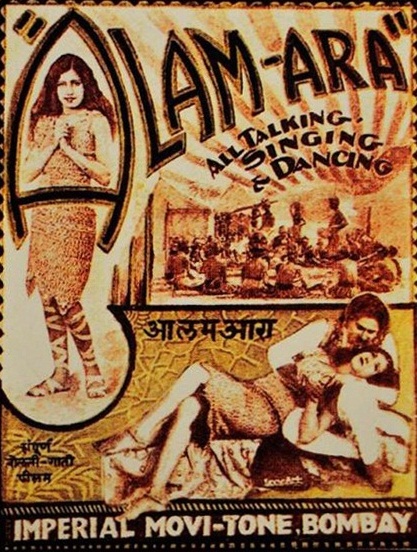
Alam-Ara (1931), the first Bollywood talkie
We Indians love our clichéd three-hour long movies featuring big Bollywood stars, catchy dance numbers, and memorable melodies, movies often set in exotic locations that are pretty but entirely irrelevant to the story, lots of romance and action, and–last but by means the least – a happy ending.
For the average Indian, Bollywood movies offer a perfect escape from the daily grind. How beloved are these movies, you ask? One of them, Diwali Dulhaniya Le Jayenge, has been running continuously in some Indian theaters since its release in 1995, and is still going strong. The title, by the way, translates in English to The Brave-Hearted Will Take the Bride, which alone tells you all you need to know about the plot.
For the outsider, this is all very puzzling. Bollywood produces about 1,000 movies a year, which is twice as many as Hollywood, but the genre is still largely unknown by the average western movie-goer. So I’ve put together a few of the more common questions I’ve been asked by my American friends about Bollywood movies.
Why are Bollywood movies so lo-o-o-ng?
A test match in the beloved sport of cricket in India can last five days, and Indians will carefully follow every ball. An Indian wedding lasts three days. So a three-hour movie isn’t that big a deal for us.
Why are there so many songs?
Bollywood movies are indeed rich in musical numbers, and, while many present-day movies are slowly moving away from this trend, it was not very long ago that 10 musical numbers in a movie was the norm. The numerous songs are a part of the escapism theme that Bollywood has always openly embraced. We’re not talking realism here. Bollywood uses musical sequences as a tool to depict the characters’ emotions and as a backdrop for the action.
There are plenty of movies coming out of Hollywood. Why watch Bollywood movies?
Why order Chinese takeout? Why eat falafel? They both have something new and different to offer. The same with Bollywood; it has its own flavor, and, for someone who loves exploring, it can be a unique and precious treasure.
Why so many clichéd plots?
It’s true that Bollywood produces many commercial “masala” movies (masala is a seasoning made of many kinds of spices, and, likewise, these movies often blend many different popular genres—musical, comedy, action, etc.) These films are often melodramas topped with action heroes, damsels in distress, and one-dimensional villains, and are commonly served with a healthy serving of sweet happy endings. But there are many other forms of Indian movies. Art cinema and experimental cinema has been ever-present since the conception of Indian cinema. Today, we are seeing the return of social activism in films, a movement that was particularly strong in the 1950’s and 1960’s (known as Bollywood’s Golden Era), and young directors today are trying to capture what it means to grow up Indian in this ever-shrinking world. With changing times, Bollywood is also changing and reinventing itself.
by Nick Porcella

Even just a few years removed, high school is a blur to me. But I do have some general memories: physics exams in uncomfortable chairs, crushes that went nowhere, never once buying school lunch and never once being ashamed of that, sweaty dodgeball gym-classes, and the most remarkable production of Les Misérables I have ever seen.
There is also the not-so-traditional memory of getting so excited by an odd piece of nineteenth-century short fiction that the rest of my life suddenly seemed to have new purpose.
My life might reasonably be broken up into two parts: B.B. and A.B., Before Bartleby, and After. “Ah Bartleby! Ah humanity!” These final words of Herman Melville’s short story “Bartleby, the Scrivener,” which I first read for Mrs. Evers’ junior-Honors English class, altered the course of my life.
I couldn’t begin to explain why the quirky narrator and his cohort of workers captured my attention as they did. But something about the writing style—its poetry and fluidity—made the novella-length story a joy to read.
The English-majoring, poetry-writing bibliophile that I am now did not exist B.B. Before Bartleby, I wanted to go to engineering school, do math and chemistry, and build things for a living. That was not the path A.B. “Bartleby” suddenly added a jolt of passion to my life that high-school-me previously lacked. I immediately shared “Bartleby” with my book-loving mother. She read it. We talked about it, why we liked it, and what those haunting final words meant to us. That was the first time my mom and I ever had a true book-club moment.
When I was growing up, my mom taught me to work hard, embrace fun, and treat people with kindness first. She tried to teach me a love of reading, but that did not stick until Mrs. Evers’ class. “Bartleby” was the story that started it all, in that it allowed me to have more in common with my mother. Ah Bartleby! Thank you!
The summer before my senior year, I went to Barnes & Noble pick out a book for summer reading. The process was always stressful for me. Should I pick a short book and spend more time writing the essays or take on a larger tome and impress the teacher? Then I saw “Herman Melville” in white letters in the foreground of a cadet-blue cover. The dauntingly long Moby-Dick sat on the corner of a shelf. I thought of my mother and smiled. In a moment that freshman-year-in-high-school-me would have found batshit insane, I grabbed the book and, without opening it, went to the register, not giving my selection a second thought.
If A.B. got me to like reading, then it was A.M-D. got me to major in English in college. I loved this massive book. And, contrary to what my high school and college friends call Moby-Dick, it is much more than a “fish story.” Call me hooked!
I tried to get anyone and everyone I knew to read Melville with me. My mom turned out to be the biggest enthusiast. I created a series of discussion questions for us, as she read the work for the first time, I for the second. She and I talked all summer about Ishmael, Ahab, Queequeg, the crew of the Pequod, not to mention the elusive yet symbolic white whale. This shared summer journey stands as a precious memory, especially now, when college has made it more difficult to see my family regularly.
Today, several years past the foundational After Bartleby period, I have an extensive collection of Melville writings, containing more than fifty-five volumes. What makes my collection even more precious is the fact that the people I love are embracing Melville with me (or at least humoring me). My friend Kaitlyn, who is a talented artist, creates a Moby-Dick work for me for my birthday each year. Last year she made a white-paper cutout of a sperm whale, which hangs in my room. My friend Molly bought me a Moby-Dick poster she saw at an online store. I had it framed and hung on my bedroom wall. My friend Susan gave me a very old movie poster of Captain Ahab which shows the captain bleary-eyed, looking for revenge. My aunt found me a Moby-Dick t-shirt which I wear to my American literature classes. My whole family keeps an eye out for all things Melville. My grandfather sends me newspaper articles and e-mails me when Melville is an answer on Jeopardy!
And my mom’s influence did not stop at encouraging my passions; she actually helped me acquire many pieces of my collection, through dumpster diving. She and I used to travel to transfer stations nearby and pick through the used book recycling bins. We were not supposed to be there, but my mom also taught me to break the rules a lot, especially if no one will get hurt. The way I saw it, all these Melville books would have been lost had I not hopped into the dumpsters full of books. I guess I became a Moby-Dick rescuer.
My proudest achievement for the collection is that I recently placed first in a book-collecting contest. I can now say that my collection is award-winning, a phrase I always preface with a laugh and the phrase “I mean this in the least pompous way imaginable.” I do not plan to stop this madness anytime soon. The only way it will end is if I share a fate with Ahab or Bartleby.
After Bartleby, my life has changed for better and for worse. I don’t have my mother anymore. Over a year ago now, she passed away after a long battle with breast cancer. My memories of her, including the times we spent reading Melville, mean more to me every day.
For many reasons, I am grateful I found Bartleby.
0
0
1
30
171
WPI
1
1
200
14.0Normal
0false
false
falseEN-US
JA
X-NONE/* Style Definitions */
table.MsoNormalTable
{mso-style-name:”Table Normal”;
mso-tstyle-rowband-size:0;
mso-tstyle-colband-size:0;
mso-style-noshow:yes;
mso-style-priority:99;
mso-style-parent:””;
mso-padding-alt:0in 5.4pt 0in 5.4pt;
mso-para-margin:0in;
mso-para-margin-bottom:.0001pt;
mso-pagination:widow-orphan;
font-size:12.0pt;
font-family:Cambria;
mso-ascii-font-family:Cambria;
mso-ascii-theme-font:minor-latin;
mso-hansi-font-family:Cambria;
mso-hansi-theme-font:minor-latin;}0
0
1
35
203
WPI
1
1
237
14.0Normal
0false
false
falseEN-US
JA
X-NONE/* Style Definitions */
table.MsoNormalTable
{mso-style-name:”Table Normal”;
mso-tstyle-rowband-size:0;
mso-tstyle-colband-size:0;
mso-style-noshow:yes;
mso-style-priority:99;
mso-style-parent:””;
mso-padding-alt:0in 5.4pt 0in 5.4pt;
mso-para-margin-top:0in;
mso-para-margin-right:0in;
mso-para-margin-bottom:10.0pt;
mso-para-margin-left:0in;
line-height:115%;
mso-pagination:widow-orphan;
font-size:11.0pt;
font-family:Calibri;
mso-ascii-font-family:Calibri;
mso-ascii-theme-font:minor-latin;
mso-hansi-font-family:Calibri;
mso-hansi-theme-font:minor-latin;}0
0
1
54
309
WPI
2
1
362
14.0Normal
0false
false
falseEN-US
JA
X-NONE/* Style Definitions */
table.MsoNormalTable
{mso-style-name:”Table Normal”;
mso-tstyle-rowband-size:0;
mso-tstyle-colband-size:0;
mso-style-noshow:yes;
mso-style-priority:99;
mso-style-parent:””;
mso-padding-alt:0in 5.4pt 0in 5.4pt;
mso-para-margin:0in;
mso-para-margin-bottom:.0001pt;
mso-pagination:widow-orphan;
font-size:12.0pt;
font-family:Cambria;
mso-ascii-font-family:Cambria;
mso-ascii-theme-font:minor-latin;
mso-hansi-font-family:Cambria;
mso-hansi-theme-font:minor-latin;}Nick Porcella studies English at Clark University, Worcester, Massachusetts, and intends to teach high school. His passions include Herman Melville, rap music, photography, and writing. He is completing a memoir, Getting to Say Goodbye. See more of his work here.
by Sasha Kohan
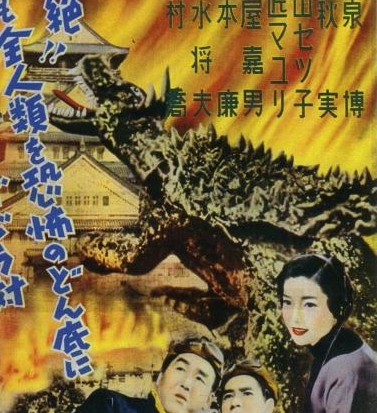
Earlier this summer, Gareth Edwards’ take on the classic Godzilla broke records for the best opening weekend of any disaster movie and creature feature, raking in $93.2 million in the United States alone. One wonders, however, how many of those millions of American viewers were aware that this film would not exist were it not for a critical moment in our nation’s history.
It was, of course, the dropping of atomic bombs on Japan in August 1945 that served as the inspiration for the saurian creature that has become the mascot of Japanese pop culture and the inspiration for multitudinous movies, books, comics, television shows, and video games. With songs dedicated to him and statues built in his honor, Godzilla has even won an MTV Lifetime Achievement Award, one of only three fictional characters to do so.
In the sixty years since Godzilla’s conception, however, the meaning behind his story seems to have changed. Japan’s original 1954 Gojira is not what we see in Edwards’ most recent adaptation (although this may not be entirely bad – the CGI creature we see now has come a long way from the delightful campiness of the original monster-suit). How has Godzilla changed with time, and will he ever become irrelevant?
The allegorical journey of Godzilla began in spring 1954, when Tomoyuki Tanaka, producer for Toho Motion Picture Company, was challenged to make Japan’s first major monster movie and decided to work the film as a metaphor for the atomic bomb.
Japan is the only nation ever to have suffered a nuclear attack. Between 60,000 and 80,000 people were killed instantly upon Little Boy’s detonation over Hiroshima in 1945, with some bodies vanishing completely from the heat of the explosion and thousands of others dying from long-term effects of radiation exposure. The death toll would eventually reach 135,000. Three days later, more than 40,000 were killed instantly in Nagasaki, with total casualties reaching upwards of 50,000. It is not difficult to understand why so much of Japanese culture has revolved around the nuclear theme.
The idea for Godzilla, however, was not inspired by these incidents alone. The opening scene of Ishiro Honda’s original Gojira, in which a fishing boat is suddenly struck by a beam of bright light, is based on the March 1954 incident when the Japanese fishing boat Lucky Dragon 5 was exposed to severe radiation and nuclear fallout from the United States’ Castle Bravo device test on the Bikini Atoll. The explosion was more than twice as powerful as the bomb designers had expected and more than one thousand times as powerful as Little Boy. “Godzilla dramatizes nuclear horror unlike any other film of its period,” says film critic Steve Biodrowski, “because the fantasy element is clearly standing in for a reality too horrible to contemplate directly.” For audiences in America and around the world, Godzilla is and has always been a fantasy, an amusement, an entertainment; for the Japanese audiences of 1954, the film struck close to home.
In the 1956 American version of the film, significant alterations were made to Honda’s original. Along with the insertion of additional footage of actor Raymond Burr as an American reporter, these alterations included the cutting of several scenes that alluded to Godzilla’s connection with the bomb. Among the omitted sequences are references to the bomb being a threat to Japan and a realistic political debate over whether the public has the right to know the truth about Godzilla, or whether they should be protected from it. The most significant reference cut from the 1956 version, however, is much smaller and more poignant, occurring when two strangers aboard a train are making small talk about the latest Godzilla news. One woman laments the headlines and the idea of confronting another tragedy. “Not after I survived Nagasaki,” she says. Another man joins in with a reference to the firebombing of Tokyo, saying, “We have to evacuate again?” Even in this fictitious universe, Godzilla is not a just an allegorical stand-in for the bomb; he is a supplement to its reality. American film editors in 1956, however, were not comfortable in this universe. Moments of truth were omitted, and Godzilla’s American legacy grew as mere fantasy.
In the half-century following the creation of Godzilla, the Toho company produced 27 sequels to Honda’s original, and a sense of patriotism eventually became associated with the giant monster. “Godzilla,” writes professor of Japanese literature Susan J. Napier, “began as the ultimate alien who, as the series continued, became a friend to Japan, an insider, ‘one of us.’” While the 1954 original depicted a Japan in panic, Godzilla showed a traumatized audience just how much they had managed to overcome. The film’s view of science, nature, and humanity remained grim and pessimistic, but the creature became a mascot for a nation devastated by war and the following period of uplift and hopes for peace. According to Napier, “The series’ reassuring subtext remains the same throughout: even if famous monuments such as Tokyo Tower or the new Tokyo City Hall get trampled on, they can always be rebuilt.”
Considering the enormous significance of Godzilla in Japanese popular culture, Gareth Edwards’ recent hit remake is all the more curious and, perhaps, problematic. Even the notion of America adapting a film and legacy which was only created because of the thousands of lives lost and despair caused by Americans is uncomfortable, to say the least. Although Japan-U.S. relations are currently stable and civil, it seems somewhat problematic for the superpower that crushed another nation to ask to borrow a most beloved icon for our own enjoyment. However, Roland Emmerich had crossed this line already with his widely criticized 1998 version, hated among critics and Godzilla fans alike, and even rebranded and essentially disowned as “Zilla” by its parent-company, Toho. In licensing the film to Legendary Pictures, Toho set certain conditions under which the film was to be made, including that Godzilla was created from a nuclear incident, and that the film be set in Japan. While these conditions were basically met, it is certainly questionable whether Toho’s expectations were. Although Godzilla’s radioactive past is often referenced in the movie, it can hardly be said that this Godzilla really has anything to do with nuclear anxiety. While the basic structure of any Godzilla film is there, it is so loose and ambiguous that it simply becomes another monster movie: huge, uncontrollable creatures suddenly wreak havoc on densely populated city and destroy cultural (American) landmarks while cookie-cutter human melodrama happens in between battle scenes. Throw in some radiation, don’t forget to mention Japan, and BOOM – Godzilla movie, done.
Prior to its release, writer Frank Darabont was asked whether the new version would uphold the original nuclear allegory or “represent a different kind of metaphor, something we’re dealing with as a culture,” only for Darabont to respond saying that, in film, there is always “a margin of interpretation.” While this is already clear to the majority of movie-watchers, Edwards’ Godzilla seems to have rather a large margin.
In a somewhat contrived effort to remind audiences that they are well aware of Godzilla’s background, the 2014 filmmakers mention the events that started it all in a quick somber scene with the lone Japanese character of Dr. Ishiro Serizawa (Ken Watanabe). Dr. Serizawa shares with a confidant (and the audience) a remnant of his traumatic past: a watch that survived Hiroshima and belonged to his father. Unfortunately, the scene is so quick and out of the blue that it feels more like a forced moment of silence before the big games starts than a sincere acknowledgment of the past.
In fact, Watanabe’s entire character appears to have been created to preserve some remnant of the true spirit of Godzilla and the culture in which he was created. By simply being Japanese, mentioning Hiroshima, and uttering the tag line, “The arrogance of man is in thinking nature is in his control, and not the other way around,” Watanabe’s role is essentially objectified and confined. The tag line is misleading, however, or at least ambiguous, in that it may delude viewers into thinking it refers to the more topical, less edgy issue of global climate change.
What stands out most in Edwards’ Godzilla, however, is the distinct Americanness in which the original Japanese story has been soaked. The only scenes set in Godzilla’s homeland occur in the first half of the film, most of which, rather ironically, take place at a nuclear plant (not to mention the opening recreation of the very same hydrogen bomb test which led to the Lucky Dragon incident, perhaps included for fans of the 1954 original. This change of emphasis also begs the question of how appropriate it would be for even Japan to produce a Godzilla remake at this time. Beginning in the early 1970s, nuclear energy has been a national strategic priority of Japan and has come to provide a significant amount of the nation’s electricity. However, following the devastating tsunami in 2011, which killed nearly 20,000 people and triggered the disaster at Fukushima Daiichi nuclear power plant, Japanese public opinion on nuclear energy has largely reverted back to what it was following Godzilla’s original release, with polls finding up to 80 percent of the Japanese population were in favor of discontinuing the use of all fifty-four of the country’s nuclear reactors.
With this in mind, it seems as though the remake of a significantly anti-nuclear-powered allegory like Godzilla might have been met with slight confusion and discomfort – no more, however, than the U.S. version we were given leaves us with. Not only does the remake cloud Godzilla’s enormous significance in a potentially offensive “Americanness,” but it also does so in a way that so strangely seems to criticize itself that one could easily read the film as ultimately un-American. The main theme of this version, as embodied by Bryan Cranston’s character and his mission, is government distrust.
It is difficult to come away from this film without questioning the politics behind it. Ideas of democracy, unity, and peace are tainted by doubt and distrust. As we watch this American version of the Godzilla story, we are only reminded of our nation’s shortcomings, historic moments of horror and regret. While at times the film seems to be an attempt to charge American audiences with pride in their nation (not unsubtly done with the recurring image of Godzilla destroying Chinatown – representative of another world superpower with which we seem to consistently compete), the movie actually instills a sense of guilt and shame for our past. The 1954 original’s sense of patriotism and reassurance is twisted by sixty years of history, and viewers walk away from the remake wondering what else we don’t know. The message is emphasized more than anything by the inclusion of an old Elvis song – and what could be more American? As “(You’re the) Devil in Disguise” plays in merry irony over the destruction of Las Vegas, suspicions that we should start being more suspicious arise, solidified by the ominous still-water ending.
While little else is clear, Godzilla viewers everywhere can at least be certain that the legacy and evolution of Japan’s beloved monster is far from complete.
by Bansari Kamdar

Romance writer Susan Elizabeth Phillips
Best-selling novelist Susan Elizabeth Phillips has been crafting funny and beautiful love stories with smart and sassy heroines, highly desirable heroes, and happy endings for more than a quarter of a century. Her latest novel is Heroes Are My Weakness.
You are considered among the top authors in the genre of contemporary romance novels. What draws you to this genre?
That is what my natural voice is. I think if you want to be successful you have to write into your own worldview and you have to work with your natural voice, and that’s mine.
How would you describe a romance novel, and how do you distinguish a love story from romance?
You can kind of distinguish in a way between a love story and a romance. I think a love story doesn’t have to end happily and the romance is going to have a satisfying ending. The hero and heroine will get together in the end and they will still both be alive. In a love story you can have a tragic ending like Romeo and Juliet. In romances, on the other hand, you don’t find that very often.
Many romance novels after a while can become clichéd; how do you overcome the stereotyping often associated with the genre?
[Stereotying] is associated with all kinds of genres in popular fiction. If you are writing a mystery, the mystery is going to be solved, and if you are writing a thriller, the serial killer will not be caught [right away]. Same way, if you are writing a romance, the hero and heroine will end up together. There is a sense of order in popular fiction that you don’t get with literary fiction. It is a sort of recipe and it wouldn’t be romance if the order weren’t followed.
There is also some bad publicity associated with romance novels. How do you respond to people who belittle the romance genre?
There is no bad PR about it anymore. That kind of went away with the popularity of the books. I haven’t had to defend the genre in a while. Not since the 80’s and early 90’s and not when you see the incredible success of so many romance writers. It’s difficult now to decide what romance is and what isn’t, because the genre is so flexible.
You have remarkably strong female protagonists in your novels from female presidents to owners of football teams and startup business owners to bestselling authors. The strength of conviction and character is often common in all these women, but what is often endearing is that they are not idealized and they also have their flaws. What is your thought process behind these characters?
You see, they achieve all this by the end of the book. My heroines since the beginning have strength of character, but are often at a low point of their lives. The process of my stories is the process of them becoming everything and the best they can be. This is an issue for a lot of women and one that interests a lot of women. [The] journey of my books is the journey of the heroine finding herself. If you look closely, the male protagonists in my novels are not perfect either. They have their flaws, and you often see them grow too, throughout the novel. If the hero is perfect and the heroine is perfect, you have no story. That is where the conflict will come from, the characters’ weakness and their needs and what they need to face about themselves.
How would you describe your ritual of writing?
I write almost every day unless I am travelling. I don’t like to take time off, even if I write just an hour a day; it keeps the work fresh. I work just like anyone works a job. I go to work in the morning and I write and I deal with all the social media things that come along. I follow a regular writing schedule.
Writers block is often a writer’s worst enemy. How do you overcome it?
Well, it’s a job. You just sit there and do it. I probably have writer’s block over twelve times a day, and so I just stay in my seat and keep working until I get through it. If it were easy we wouldn’t call it work.
Do you have any advice for other writers?
It’s hard work, and the only way you can get anything accomplished is by actually doing it. That’s the hard part. It is easy to go to workshop and meetings, but sitting down in the chair and doing the writing is when it actually happens. So my advice always is “Write, just write. “
What do you do in the time you are not weaving romances on paper?
There is always hiking and travelling. We also have family close by so we do a lot of family gatherings. And of course I love to read.
So, what would you say would be your 3 favorite books?
No, I am not answering that question. It’s just too hard.
I just finished reading The Great Escape last month, and, as an ardent follower, I am wondering what is next in the books for Susan Elizabeth Phillips?
As you must have read on my blog, I am coming out with my new book Heroes Are My Weakness. A sneak peek of the novel is available on the author’s website.)
The Chicago Stars series, with its football-playing heroes and daring heroines who fall in love with them, is a public favorite, and two of my favorite books are also a part of these series. Are there going to be any more Chicago Stars books after Natural Born Charmer?
I have always said that I have written my last Stars book, but if I get an idea for another one I would definitely write it. I just have to be able to bring something fresh to it.
I remember reading It Had To Be You in high school and how motivated Phoebe made me feel, and I am sure a lot of women around the world associate themselves the same way with many of your characters. What would be your advice to these women who are still on the journey of seeking themselves?
My advice would just be that, keep testing yourself and keep growing.
by Noah Keates
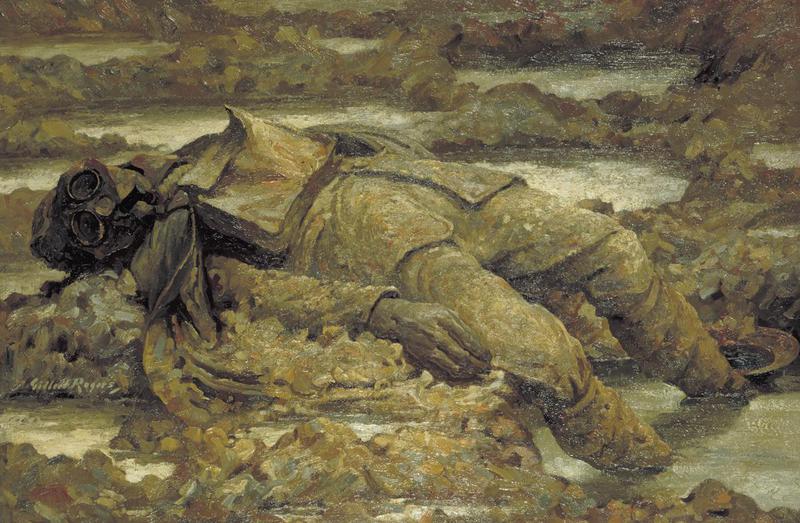
Imperial War Museum via Wikimedia Commons
A century ago, on June 28th, 1914, Slav nationalist Gavrilo Princip assassinated Austrian Archduke Franz Ferdinand of Austria in Sarajevo, and many historians would concur that this was the ember that was blown into the conflagration of the First World War. But although the archduke’s assassination may have been the catalyst for the subsequent war between Austria-Hungary and Serbia, the eruption of war on a continental scale may have been caused by other factors. Decades of political distress and foreign alliances had set the stage for the behemoths of European military power–England, Germany, Russia– to take up arms. And at the center of this stage stood three cousins, King George V of Great Britain, Kaiser Wilhelm II of Germany, and Tsar Nicholas II of Russia, whose complicated family relationships partly fueled the international animosity that led to the horrors of The Great War.
George and Wilhelm shared a common relation through their grandmother Queen Victoria, while George and Nicholas were bonded through their mothers, the two Danish princesses, Alexandra and Dagmar. Nicholas and Wilhelm shared no blood relation, though they became cousins-in-law when Nicholas married Wilhelm’s first cousin, Alexandra of Germany.
The three cousins grew up under great pressure from the past, and the political leanings of their predecessors molded their opinions and ideas as they rose to power. Though tension existed among the three nations in the decades preceding World War I, the young cousins remained in contact with each other, partially driven by the expectation of courtesy from their common relations, yet also due to a genuine interest in the lives of their social counterparts. However, through the first decade of the 20th century, the bonds among George, Wilhelm, and Nicholas began to be strained.
Queen Victoria acted as one of the strongest influences on two of the young boys, as she grandmothered both George and Wilhelm. Victoria ruled in Great Britain for 64 years from 1837-1901, and acquired the name “The Mother of Europe” due to the number of thrones occupied by her descendants. A special bond quickly developed between the Queen and her first-born grandchild, Wilhelm, in whom Victoria keenly inculcated the appeal and successes of British culture and policy. Wilhelm would acquire great power in adulthood, and Victoria intended to capitalize on the mutual affection with her German grandson to influence German political policy in a direction favorable to Great Britain. However, although the Queen guided Wilhelm towards British influence, she did not encourage the friendship between Wilhelm and the one person who could have cemented the Kaiser’s positive relationship with her island nation, her younger grandson, George, the future king. Victoria disliked the idea of her grandchildren mingling together and kept a general policy to “avoid having more than one set of grandchildren staying at any one time,” according to historian Miranda Carter. Consequently, Wilhelm and George did not form any real relationship as children, which might have induced a stronger bond between the two rulers as they rose to power.
Victoria was not the only one to discourage this friendship. George’s mother, the Danish Princess Alexandra, still harbored resentment towards Germany stemming from the brutality of the Prussians towards her kingdom in the Dane-Prussian War of 1864. Otto Von Bismarck, the German chancellor, had orchestrated this conflict to aid in the unification of the German state and to cement a political alliance with Austria, who offered military support in the struggle. Alexandra also fostered the bond between George and her sister’s son, Nicholas II. Nicholas made the long trip across the continent with his Danish mother, Dagmar, to visit his British cousin, and the two quickly developed a strong bond that would persevere through the hostility between Russia and Great Britain in the final decades of the 19th century.
Through the Danish sisters and Queen Victoria, a social dynamic quickly formed among the three cousins, in which Wilhelm constantly found himself on the outside, isolated on both sides by anti-Prussian feelings.
From the early years of their reigns, a game of influence and power quickly developed among George, Nicholas, and Wilhelm, each looking to seize the political advantage over the other. Wilhelm grew to favor Russia over Great Britain, deeming it a necessity to form an alliance with one of these countries in order to prevent an alliance between Great Britain and Russia that would leave Germany flanked to the east and west by two of the strongest military forces in Europe.

Nicholas and George (via Wikimedia Commons)

Wilhelm (via Wikimedia Commons)

Illustration by Noah Keates
Wilhelm, for his part, saw an opportunity to capitalize on younger Nicholas’s political inexperience and influence the recently crowned Tsar. Although some hard feelings existed between the two young men due to their common romantic interest in Alexandra, who became Nicholas’s wife, the Kaiser overcame this envy in order to attain a Russian alliance. Wilhelm aggressively forged a friendship Nicholas, soaking him in compliment and flattery, and tired to mold his political ideas, according to historian Robert K. Massie. At first, Nicholas embraced the support of the older more experienced Wilhelm, seeing him as a mentor. However, as the years passed, and the tsar accumulated experience in the political world, he began to find Wilhelm’s influence as more overbearing than helpful. Nicholas had a greater interest in maintaining his relationship with his long-time friend George, a friendship that became increasingly difficult as Great Britain and Russia’s always tense relationship stretched thinner. However, guided by similar influences as children and similar interests as adults (each was extremely fond of his nation’s navy), the relationship between the two remained cordial.
While Nicholas and Wilhelm had obtained their thrones as young adults, George’s father, Edward VII, remained king until almost the eve of the War, meaning that the friendship between George and Nicholas did not factor into the politics of these rival powers. But when George ascended the throne, this bond became crucial in the arrangement of pre-war alliances. And as George and Nicholas forged a bond between Russia and Great Britain, Germany became more isolated.
By 1907 the Triple Entente had been formalized, officially forming the political alliance among Russia, Great Britain, and France. Three years later, upon Edward’s death, George at last acquired his throne and he and Nicholas could meld their life-long friendship into political reality. At the same time, Nicholas’s growing annoyance at the Kaiser escalated to contempt. Encouraged by Wilhelm, Nicholas had waged war with the Japanese in an effort to acquire a warm-water port on the pacific, but this military campaign ended in catastrophe, with Russia’s seemingly superior forces decimated by the smaller Japanese army. This was the final straw for the Tsar.
To make things worse, this defeat in the east along with a host of social and economic issues caused a growing animosity towards Nicholas in his own country. With the deterioration of this relationship between Tsar and Kaiser, tension emerged between the two nations.
There is no doubt that numerous factors contributed to the rising animosity among nations that erupted into World War I. However, the social dynamics of Wilhelm finding himself the odd-one-out in the family from an early age and his struggling to join the previously existing friendship between George and Nicholas may also have played a part. It is amazing, and saddening, that the projection of a family’s dynamics onto the global scene in the form of shifting national alliances could have consequences as global and as horrific as the First World War.
Noah Keates is a junior at the Bancroft School, Worcester, Massachusetts. His interests are history and politics, especially concerning Europe, and he hopes to study political science in college.
0
0
1
30
171
WPI
1
1
200
14.0Normal
0false
false
falseEN-US
JA
X-NONE/* Style Definitions */
table.MsoNormalTable
{mso-style-name:”Table Normal”;
mso-tstyle-rowband-size:0;
mso-tstyle-colband-size:0;
mso-style-noshow:yes;
mso-style-priority:99;
mso-style-parent:””;
mso-padding-alt:0in 5.4pt 0in 5.4pt;
mso-para-margin:0in;
mso-para-margin-bottom:.0001pt;
mso-pagination:widow-orphan;
font-size:12.0pt;
font-family:Cambria;
mso-ascii-font-family:Cambria;
mso-ascii-theme-font:minor-latin;
mso-hansi-font-family:Cambria;
mso-hansi-theme-font:minor-latin;}
0
0
1
820
4679
WPI
38
10
5489
14.0
Normal
0
false
false
false
EN-US
JA
X-NONE
/* Style Definitions */
table.MsoNormalTable
{mso-style-name:”Table Normal”;
mso-tstyle-rowband-size:0;
mso-tstyle-colband-size:0;
mso-style-noshow:yes;
mso-style-priority:99;
mso-style-parent:””;
mso-padding-alt:0in 5.4pt 0in 5.4pt;
mso-para-margin-top:0in;
mso-para-margin-right:0in;
mso-para-margin-bottom:10.0pt;
mso-para-margin-left:0in;
line-height:115%;
mso-pagination:widow-orphan;
font-size:11.0pt;
font-family:Calibri;
mso-ascii-font-family:Calibri;
mso-ascii-theme-font:minor-latin;
mso-hansi-font-family:Calibri;
mso-hansi-theme-font:minor-latin;}
by Sarah Leidhold

I heard the poetry of Andrea Gibson before I read it; and I’m not sure if that is considered cheating, like giving one’s eyes the pleasure of watching the movie before the more satisfying labor of earning the narrative through the exploration of reading. A crony of mine posted a link of her spoken word session on Facebook, making a bold statement about her brilliance. Because I respect the opinion of this friend, my fingertips instructed the mouse to click, and, as requested, I turned up the volume.
What I heard then was something I never forgot. It was Gibson’s piece, “Maybe I Need You,” about the prickling nostalgia of having your hands ache to hold someone who is entirely too gone to fathom. I myself wasn’t hurting at the time, but when heartbreak did befall my soul, I craved the sound of her rhythmic vocalizations and the piece’s exactly on point descriptions of the rollercoaster of human emotion.
I sought out her writing more and more, finding my own writing muse gaping at her creative insightfulness and begging that my words would try to mimic it. As cliché as it may sound, Gibson was my compass through a summer tangled with the dark disillusionment of love lost. And since then, I have made her my poetical goddess, referring to her when I need a wisp of inspiration or when my heart is feeling hollowed out or much too full. Last year I witnessed her reading live and I completely saturated the basins of my cheekbones with saline–crying for the incomprehensible beauty that I was witnessing.
Gibson’s book of poetry, Pole Dancing to Gospel Hymns, was published in 2008 by Write Bloody Publishing. with a new edition coming out in 2010. Featuring illustrations by Anis Mojgani, the book was awarded the DIY Book of the Year and was nominated for the Pushcart Prize. Pole Dancing to Gospel Hymns contains 26 poems, most written in free verse, with some sporadic rhyming.
Within these texts, Gibson stares into the face of the forces of evil that are cloaked in propriety or tradition in our world and gives us the gory details: patriarchy, warfare that slaughters children on US dollars (“El Mozote”), the Post-Traumatic Stress Disorder that soldiers bring home from war, mental health issues, the horror of rape, the injustice of laws that do not allow gays to marry, the wrongful assumptions of sexism, the avarice inherently interlaced with our consumer culture, and more. She dexterously contrasts the stark blackness of these horrible truths with the saving grace of much more gentler forces like forgiveness, love that spans across boundaries of gender or race, the innocence of children, the unrelenting promise of pacifism, and, above all, the power of altruism as the guiding force for human harmony.
Gibson juxtaposes two opposing images of mankind: one as a monstrosity that employs indiscriminate violence to satisfy its bottomless greed under the guise of religious convictions, and the other a creature capable of breathtakingly profound descriptions of the specificity of things, both internal and external, that make the human race such a beautiful species, one that harbors more potential for compassion than it is capable of realizing.
Gibson fleshes out images/instances of both love and hate: personifying both empty clichés about romantic relations and stark facts about the horror of war. Her poems speak with the breath of human life by painting portraits of people, things, and emotions with a crafted realism. But Gibson also whispers into the reader’s ear idealistic ideas that fill one with hope that the world can be improved, as in “See Through”:
“And Jesse this
is not just a picture [of] our history,
not just a picture of our past.
We’ve been hundreds of years
Measuring the size of their hearts
By the size of our fists,
Erecting our bliss on the broken backs of dark skin.
The present is far from gift-wrapped”
Besides being a poet, Andrea is an activist who urges us not only to be aware but also to work for change. Again, from “See Through”:
“I don’t believe we’re hateful.
I think we’re just asleep.
But when we wake we can’t call up the dead and say,
‘Sorry, we were looking the other way.’
There are names and faces behind our apathy,
eulogies beneath our choices.
There are voices deep as roots
thundering unquestionable truth
through the white noise that pacifies our ears.
Don’t tell me we can’t hear.
Don’t tell me we don’t hear.
When the moon is slain,
when the constellations disperse like shrapnel,
don’t you think it’s time
something changed?”
The title of Gibson’s collection, Pole Dancing to Gospel Hymns, suggests a rebellion against traditional principles and authorities, but not all of Gibson’s work focuses on extremes of human pain and injustice. She also has pieces that completely focus on the bliss of finding harmony in relationships, especially romantic ones, as in “Love Poem.” She also discusses the heartache of relinquished connection with another in writing that moves one’s heart.
Gibson’s writing often makes allusions to history, current events, and other literature, as well as employing metaphors and extended metaphors.
Anyone who picks up this book should prepare to be moved, to heave open one’s heart. This writer’s words have become for me the poetic equivalent of Thomas Paine’s “Common Sense”—it’s a call to arms, a pamphlet that reminds me of the necessity to rebel against the thoughtlessness that keeps the veil over our eyes in this culture.
Sarah Leidhold, an overzealous student at Worcester State University, harbors a pervasive addiction to both producing and absorbing poetry. She especially enjoys the uninhibited spilling out of inspired sentiments in the all-accepting form of free verse. More of her work can be found here.
by Warren Singh

J.D. Salinger once noted that a good book was one that made you wish you were friends with the author. By that measure, I’m reading a good book, even if Nassim Nicholas Taleb is coming off as a bit of an ass. Well, a lot of an ass. But that’s okay, because, apparently, so am I.
I’m just finishing up Fooled By Randomness, a 200-something page book published by Random House that Taleb describes as a personal essay, intended to be read for fun, about “the hidden role of chance in life and in the markets,” as the subtitle has it. Taleb weaves in threads from psychology, economics, philosophy, finance, history, classic literature, probability theory, and anecdotes. In short, the book is an unconstrained story, going wherever it pleases, sprawling out around a central theme like an aerial view of London at night.
What’s the theme? Taleb writes, “I have been periodically challenged to compress all this business of randomness into a few sentences … it is: we favor the visible, the embedded, the personal, the narrated, and the tangible; we scorn the abstract.”
It’s simultaneously discomfiting and liberating to consider Taleb’s central point is that randomness is fundamental in much of our lives. Throughout the book, he expounds on the idea that we are so much less in control of what events occur than we think – we correct our past predictions in hindsight to appear more correct to ourselves, we convince ourselves that we are solely responsible for the good things that happen to us due to our actions, and we become married to our first ideas and beliefs, defending them against any and all incoming evidence to the contrary.
Taleb doesn’t argue that life’s underlying randomness is good or bad per se, he argues for its deep-running nature and indelible impact on our lives, and expounds on this idea that we cannot see it because of our inborn psychological patterns and fallacies. We are, if I may use a neologism, randumb.
Writing in a distinctive, personal voice, Taleb spins out this idea into its many facets, from financial markets to our personal lives and decisions, ultimately musing on the bad (and good) aspects of being so inextricably bound to the vagaries of chance. In the end, Fooled By Randomness is a conversation with an uncle at a family gathering, one who is unashamedly opinionated and iconoclastic, bordering on overbearing – and yet, entertaining, thought-provoking, insightful and very much worth the time.